Backcountry Review
Issue No. 9
Surfer Mikey February finds his flow.

Climber Cedar Wright embraces his inner dirtbag.
Carolyn Finney examines inclusivity in the outdoors.
Ben Masters documents North America’s wildlife legacy.
Live Free & Transcend
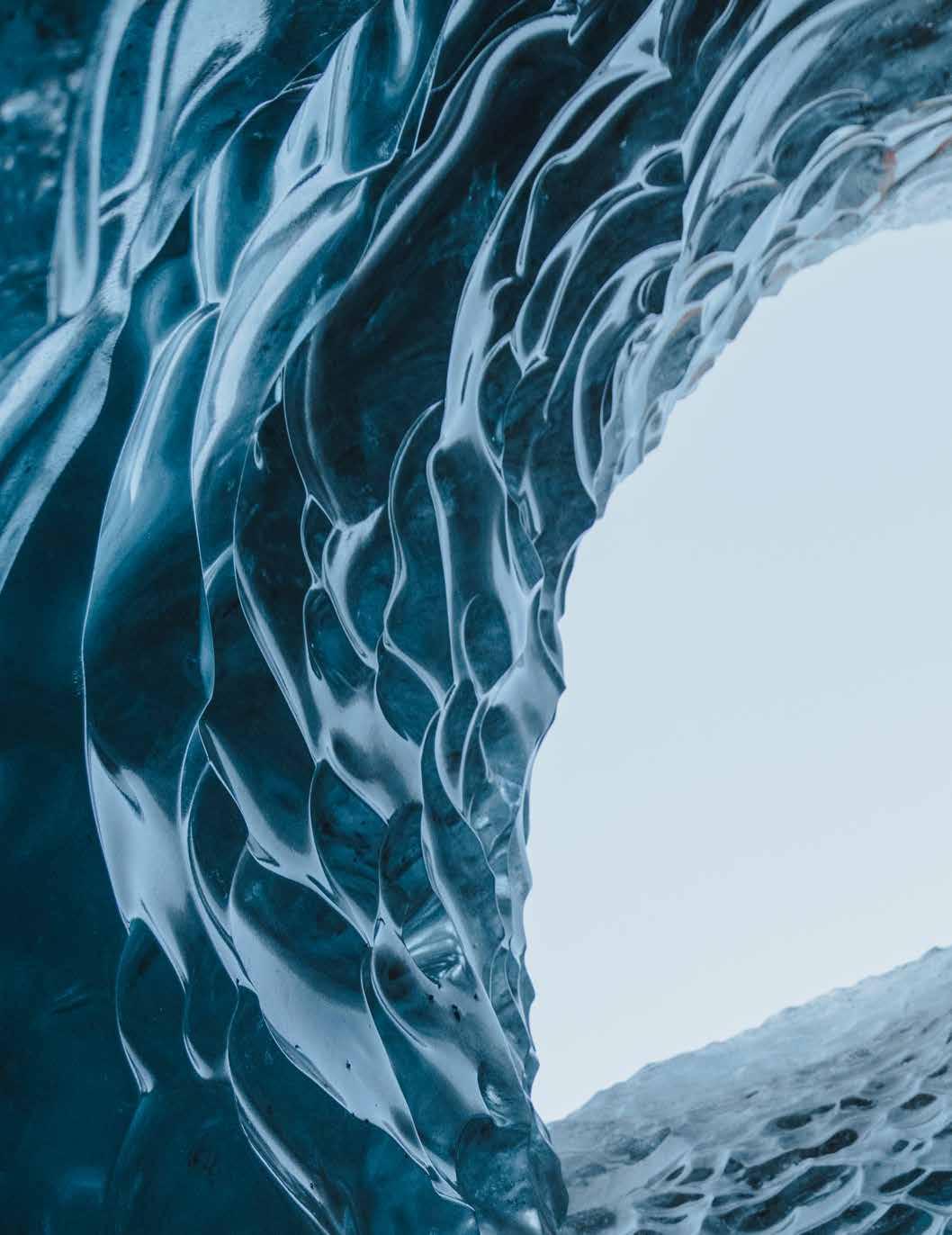
Bridging Worlds Olympic Ascendance Summiting Denali Preserving Yakona Bouwman Blood Springfield High School’s Miller Integrated Nature Experience (MINE) gives students a look at Oregon they may never see otherwise. The program combines nature writing, Oregon geography, leadership, and journalism while providing a foundation for environmental consciousness and stewardship. Send all inquiries to ivan.miller@springfield.k12.or.us or 875 7th Street Springfield, OR 97477 4 18 20 52 58 64
Rediscovering Tradition
Cover photo by Alan van Gysen
Editors-in-Chief
Carly Bramhall
Jay Bramhall
Yuriana Espino Sosa
Managing Editors
Kevin Gustafson
Hannah Holman
Copy Editor
Drew Campbell Writers
Amanda Arch
Courtney Brown
Landon Cowan
Talia Hosford
Kaden Hurley
Bryan Lomeli
Kassandra McLennan
Damian Rivera
Caden Trieu
Creative Director
Juniper Wollock
Graphic Designers
Emely Castanada-Rivera
Elijah Lowder
Natalee Ness
Trevor Pasquali
Grace Paugh
Vanessa Smith
Digital Artist

Koda Mihm
Photographers
Madison Blaine
Hollander Bishoff
Advertising Manager
Lucas Paugh
Communications
Mayah Pappas
MINE Director
Kayla Unrein Adviser
Ivan Miller
Photo by Donal Boyd

4
Preserving Yakona


JoAnn and Bill Barton pull off an impossible dream and find meaning in creating the Yakona Nature Preserve.
Yuriana Espino Sosa Contributed
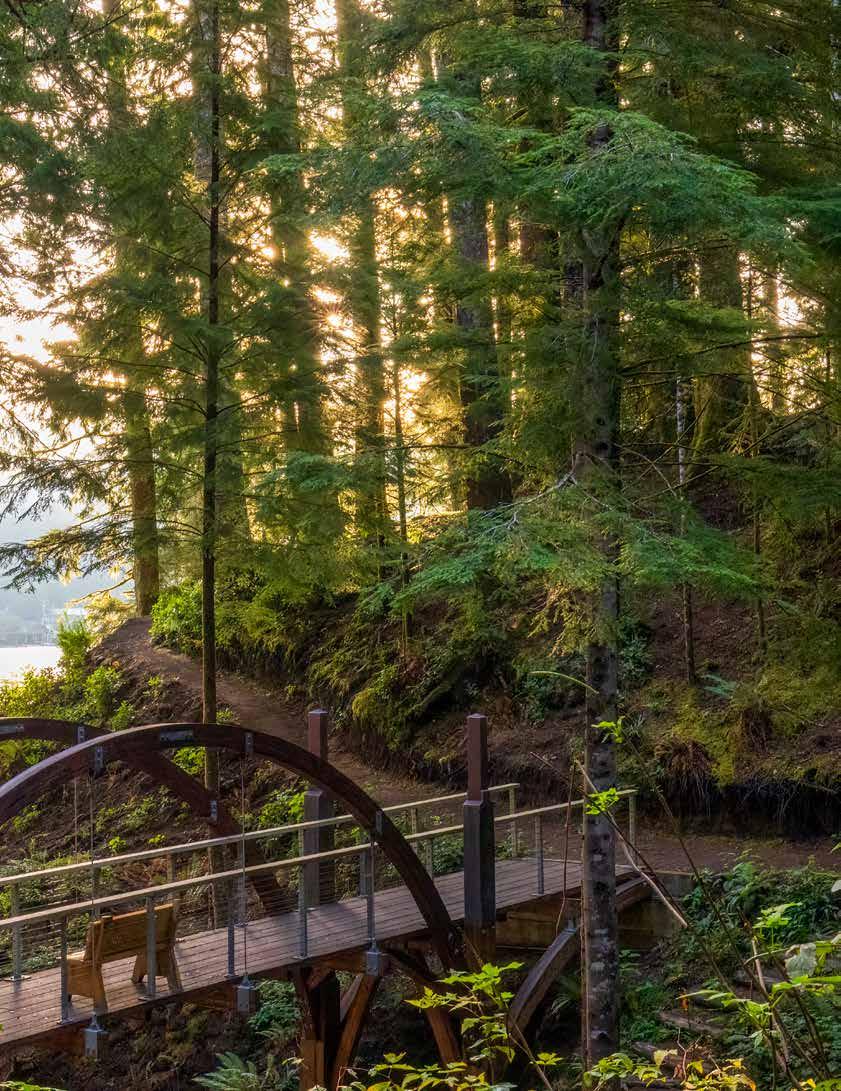
5
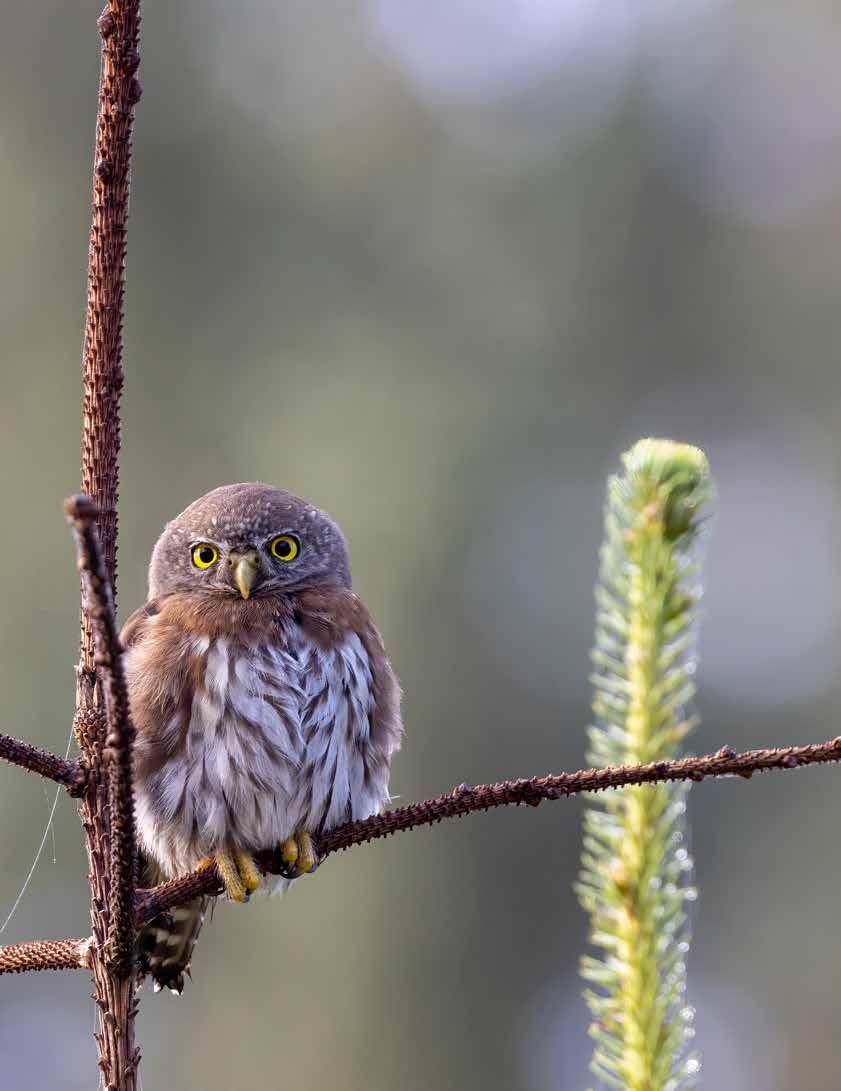
On October 21 of 2022, I traveled with ten other students from Springfield High School’s Miller Integrated Nature Experience (MINE) to the Oregon coast to see the Yakona Nature Preserve, where we met with owners JoAnn and Bill Barton, who spoke extensively about the history and beauty surrounding the 340-acre preserve. We walked along a trail, occasionally stopping to listen to Natalie Schaefer, executive director of the preserve, outline the history of the land. At one stop, we came to a bridge. At the center of the bridge sat a single wooden bench overlooking the Yaquina River. Bill stopped at the center, everyone circling around him. As Bill’s voice started to crack, he recalled a story of a mother bear and her two babies that were hit crossing the highway and had to be euthanized. “What are we doing here? What are we thinking about? And I know bears are scavenger hunters, I know they’ll get in the garbage can, I know it,” said Bill, who hopes the preserve might partially work as an animal sanctuary.
The thought of creating Yakona in 2010 started as an “impossible dream,” as he likes to call it, and has centered around the animals occupying the land. “I don’t do anything out here anymore that the bears wouldn’t approve of.”

with her community.
“I started volunteering for a charity event for our Children’s Advocacy Center,” says JoAnn. She ended up serving on the board of directors and working with the center for 10 years.
Bill, on the other hand, spent most of his childhood in Alaska, surrounding himself with wildlife. His father was a bush pilot in southeast Alaska. “When I was a little boy we were very much involved in the outdoors —hunting, fishing—all the time,” he says.

Moving into adulthood, he eventually studied law, serving as a trial lawyer for over 45 years.
The idea of Yakona was suggested by family friend Dean Philstrom. Originally, they contemplated buying land to make a park. They wanted to provide a green space for their community, considering themselves “community gooders.” The only obstacle blocking them from the dream was purely financial. Initially, they didn’t have enough money to make it work, but a tight 80acre rectangle right in the middle of the Yakona peninsula was purchased by a logging company. After the company logged 47 of the acres, the sale price dropped dramatically. So in July 2013, the Bartons made the first purchase of 77 land parcels.
The Bartons married in 2003. JoAnn moved to Newport in 1996, with her previous husband and kids. JoAnn graduated college with a psychology degree while her kids were still young and dedicated most of her life to her children. In 1998, her husband passed away due to brain cancer. She and her kids took some time to heal but eventually she knew it was time to find something to throw herself into. She got involved
The history of Yakona goes way back to the first people to settle in Yaquina Bay, the Yaqo’n tribe. They lived between the regions of Cape Foulweather and Beaver Creek. When the European colonists came to Oregon they brought disease–measles, tuberculosis, smallpox, and gonorrhea–to natives. By the late 1700s, disease claimed about 80 percent of the natives, including the Yaqo’n. In 1855, the United States government decided to create reservations and relocate native people. About 2,700 indigenous people from 27 different tribes were moved to Florence, a region bounded by the Siuslaw and Umpqua Rivers, stretching 20 miles inland. People from all over California and Washington
7
were forced to move within this reservation, including the Yaqo’n. Natives were told to leave everything behind, as they were promised food and housing at their new residence.
Upon arrival, they realized none of it was true. The Yaqo’n people were integrated with 27 other tribes who did not share the same language and did not eat the same food; most of them unaware of the various customs and traditions. The Yaqo’n people helped keep all of these people alive that first year.
The promise to protect these tribes was broken in 1865 when the federal government removed the Yaquina watershed out of the Siletz reservation and opened it up for white settlers, who took the homes of the native people, among them the Yaqo’n. In addition to all the diseases, massacres, and all the people who lost homes, by 1892 only 14 Yaqo’n people remained.
The Bartons’ goal is to restore the native coastal land on Oregon’s Yaquina Bay. Ever since the first purchase was made, nine years ago, the Bartons have dedicated their time to Yakona. It takes about 20 to 30 percent of Bill’s time, while he still practices law, and all money earned goes into Yakona. It’s “a big baby that takes up a lot of time,” says Bill. As for JoAnn, she spends 40 to 50 hours per week on the land.
To this day, they have made about 15 individual purchases, acquiring over 340 acres. They’ve also planted over 10,000 native trees and shrubs, among them 7,000 Sitka spruces. They have put in over five miles of trails, hoping to make something for the community as well as the local wildlife. Their last purchase entailed about 50 acres, on which they will not be building any trails, simply setting aside some space for the benefit of the animals.
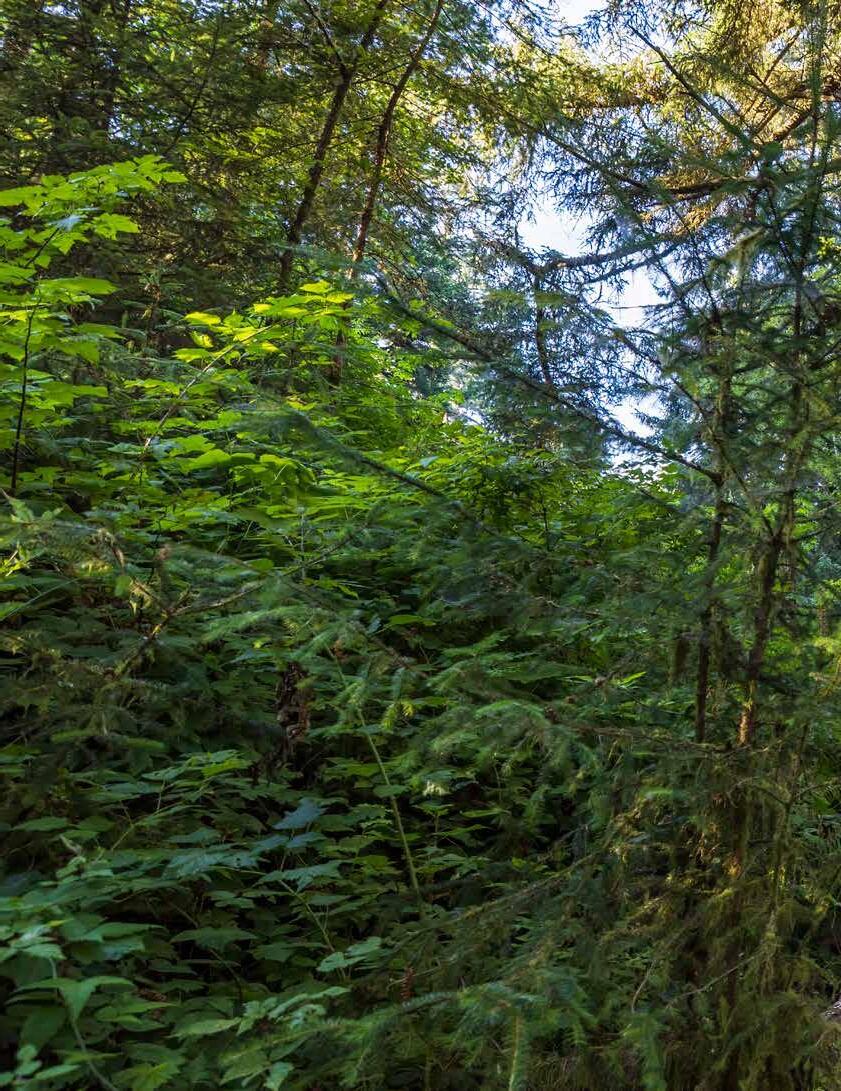
“We’ve done enough for the public and we’re grateful to have done it,” says Bill. “But now it’s time to shift the focus to the animals.”
What JoAnn loves the most about Yakona is the few big ancient trees that have been there since there were few inhabitants made up of small clans and bands of the native people.
“These trees have witnessed the passing of centuries, and I stand with them in their presence, and I feel so small, in a good way,” she says. “I can stand with these trees, smell their bark, smell the moss on the bark, and just feel small, in a really healthy way. I think that’s what I value most.”
“I feel very blessed and grateful that the two of us have been able to find something in this mortality,” says Bill. “It’s something we can share together.”
The love they share for Yakona started as a dream, hoping they might make something of value for the community. The MINE students visiting the preserve made an impact on the Bartons. “I think you guys were the most engaged group of young people we have ever had out here,” said Bill that day.
For the past nine years, MINE has been all about the community, both the human and the ecological. We are out reporting on the real world, researching heavy topics, meeting people that make a difference in the world. And like the Bartons, MINE started as a dream, in a classroom, with no money, no publications.
What I love about MINE is that I get to write about whatever I want, I can use my voice, and I get to go on adventures and meet people like the Bartons. Many students come to this program with zero journalism experience, but within six months we have learned how to make a magazine that cares about the people it represents and the outdoor world. If we can do that in a few months and JoAnn and Bill can create a place for the community within a few years, then I think we can all strive to make a difference in the world, where anything can be possible.
8
 Rena Olson hugs a massive tree on the Yakona Nature Preserve.
Rena Olson hugs a massive tree on the Yakona Nature Preserve.
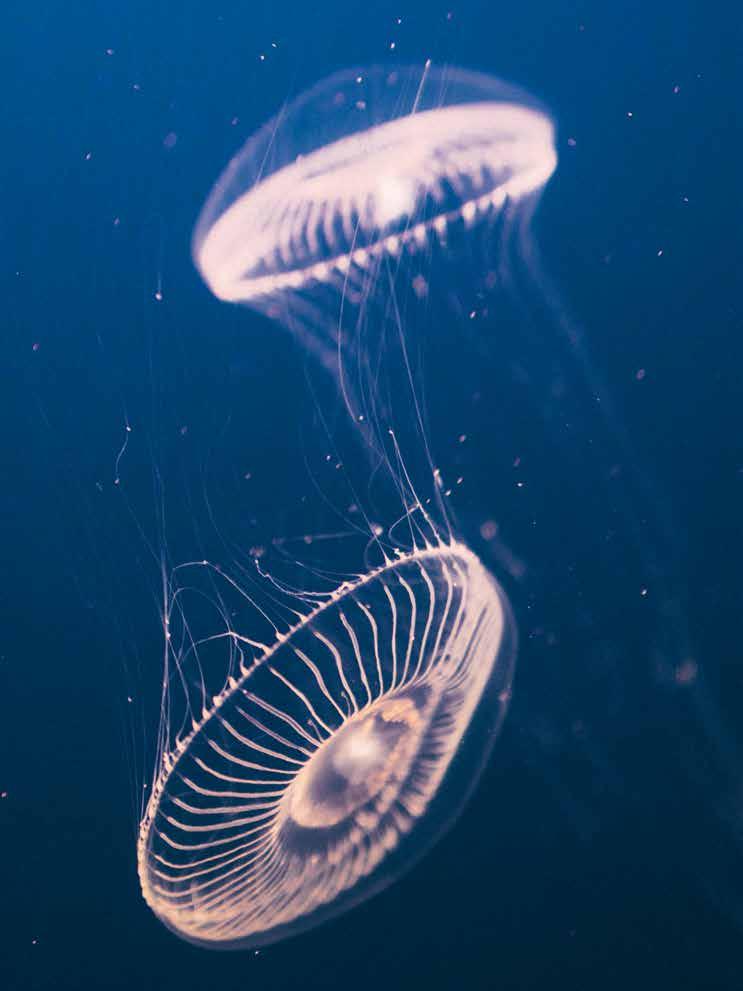
10
Capturing the Moment
Erin Sullivan rediscovers her passion for photography and storytelling, reinventing herself through her work.
Kayla Unrein Erin Sullivan
Photography provides a way for people to connect, whether it be with others or with the world. Moments, landscapes, people all become art, capturing new perspectives and preserving stories. Photographer Erin Sullivan has captured incredible images and aims to share them with the world.
Sullivan has always shown signs of creativity. Her mother and grandfather made time for artistic endeavors, and showed her the importance of play in life. She tinkered with photography when she was just 15 years old, shooting in black and white on her dad’s Nikon FE. While learning the art of photography in high school, she quickly discovered a creative way to express herself.
“It was the first time that I really was able to express myself in an artistic way,” says Sullivan. “Photography was a way to share the way that I saw the world and these little moments that were happening around me.”
In college, she meandered her way through a few majors, eventually landing on environmental studies. After college, she yearned to see the world and decided to work as an adventure guide for middle schoolers and high schoolers, traveling to places like Europe, China, and Australia. She experienced so many different cultures and places that she otherwise wouldn’t have been able to see. And though the trips were very rewarding, they were draining, and she longed to come home. Upon returning, she started a blog called Erin Outdoors, returning to photography as a way to document her journeys. Suddenly, she found purpose.
“When you really love something like that, when you really feel drawn to it, it’s never going to really leave you,” says Sullivan. “It kind of chases you until you pay attention to it.”
After moving to Los Angeles, Sullivan connected with Instagram influencer Rachel Rudwall. Sullivan had followed Rudwall for a few years, and while sitting for coffee, Sullivan asked Rudwall if she wanted to go to New Zealand and photograph glow worms. Rudwall was ecstatic and agreed. They spent three weeks in New Zealand together.


“We saw some really beautiful nature. We learned some very interesting stories. We met people… That was a meaningful experience to me because I was getting the opportunity to bond with somebody,” says Sullivan.
Faced with the Covid-19 pandemic, everything changed for Sullivan, who was forced to reinvent herself. She called this her miniatures project phase, in which she made outdoor-like landscapes from simple household items. With no people to photograph, she took miniature figurines and put them in these locations, and continued connecting with people via social media.
“I created these really big outdoor scenes that create awe and wonder,” says Sulivan. “I used cucumbers or sheets or pillows, and I just want to inspire people to see magic in everything.”
Sullivan hopes her innovations in photography will inspire others to capture their own moments.
11
Photo Essay
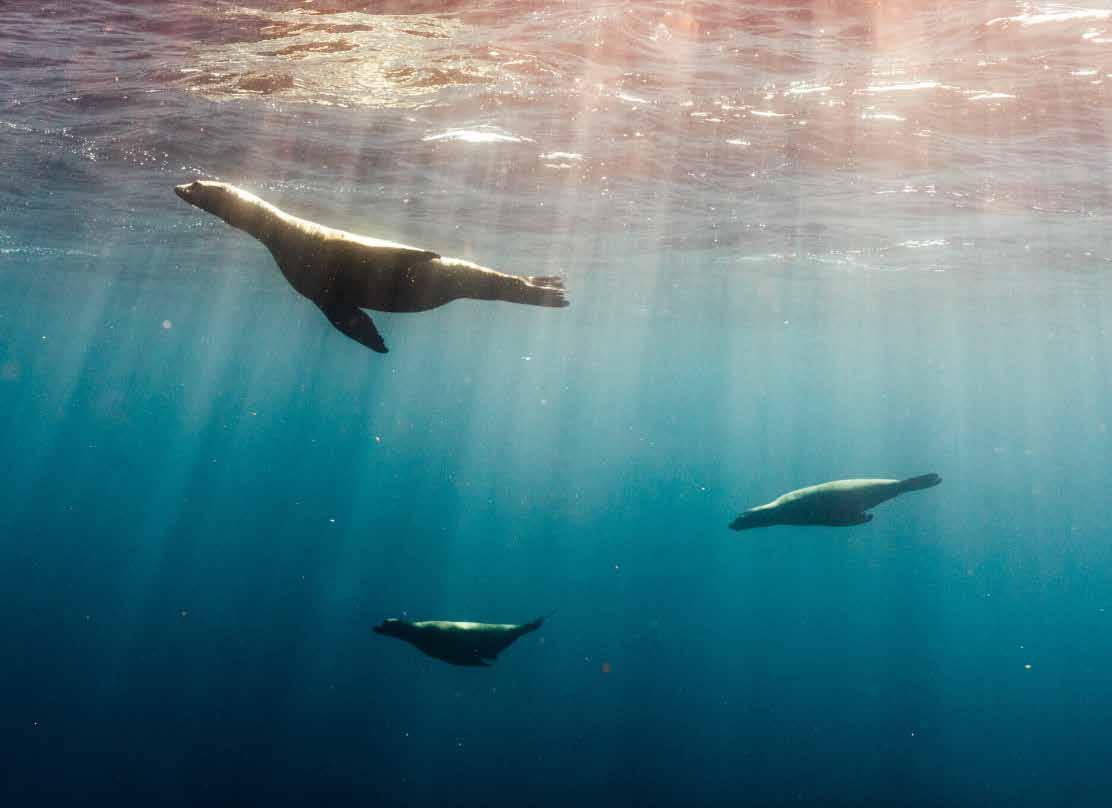

12
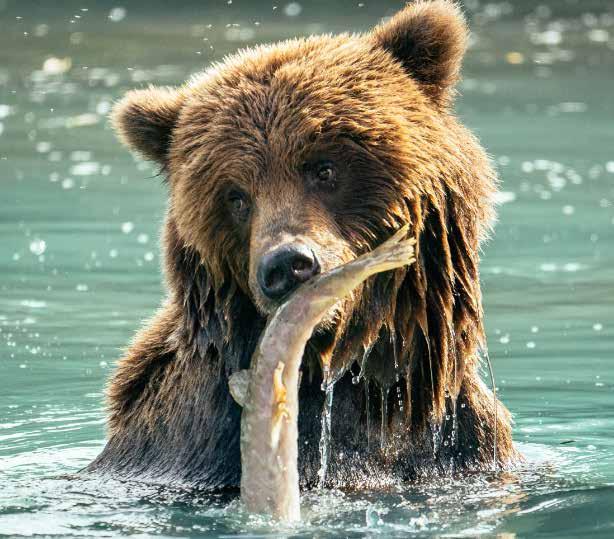

13


14


15
Backcountry
InspIratIons
Everyone has a story to tell and every story has a lesson to teach. From all ends of the world, these outdoor adventurers inspire people everyday.

16
 Climber and USC runner Lucy Westlake marvels at a mountain view sunrise.
Climber and USC runner Lucy Westlake marvels at a mountain view sunrise.
Connection
Professional skier Connor Ryan explores the rugged terrain of his native culture and tradition.
For a long time Connor Ryan’s hobbies and passions existed in a separate realm from his identity as a Lakota native, in a space somewhere between Western and indigenous culture. Ryan’s standard American education backed up the belief that people are separate from nature, but learning about his tribe and their spirituality revealed that people are a part of nature.
Ryan says, “[nature] isn’t an area that we can just forever like to cordon off and charge people to get into and say, ‘you need all this special gear and all this special knowledge.’ We’re human beings. We come from the land. Every molecule of our body was once a part of Mother Earth, the planet.”
Ryan is not a traditional professional skier. As a Lakota, Ryan uses
his platform and outreach as a skier to help native people break into skiing culture. He partners with larger companies, like REI Co-Op, to create ski films that bring attention to how much native people struggle with identity.

Two years ago, Ryan started partnering with Natives Outdoors to start an Ikon Pass scholarship for native kids to ski or snowboard. This year, Winter Parks Resort, the mountain Ryan calls home, joined the collaboration and started sponsoring passes, rentals, and lessons for native and indigenous people.
During childhood, Ryan’s white father gave him the financial means and the opportunity to ski as a child. Being half white allowed Ryan to fit in more seamlessly to the white-dominated ski world. For Ryan, skiing satisfied a need to connect to nature.
At 5 years old, he fell in love with Eldora Mountain Resort, the switchbacks subconsciously soothing something in Ryan until he was 10, when
his father’s construction company went out of business, the family suddenly dependent on food stamps.
In the suburbs of Colorado, growing up disconnected from his tribe, the culture around skiing was one of privilege. When Ryan lost his socioeconomic means as a young kid, the privilege of skiing was ripped away, but it wasn’t just about skiing, it was about connecting with nature. Skiing kept Ryan unknowingly close to his native ancestors. Being without it took a toll on Ryan throughout his teen years.
Adulthood offered some financial freedom, and with a good paying job and time on his hands, Ryan purchased his own ski pass. He rekindled his love for skiing alone. Ryan started skiing as a Lakota.
Ryan turned to his next challenge: love and belonging. In 2014, at 21 years old, Ryan then attended a native hip hop concert by the artist Superman. Ryan immersed himself in the developing native hip hop scene in the Black Hills of South Dakota. He had never heard anyone sing about things that affected him so deeply. Ryan started making meaningful connections with others from his tribe, meeting people who held ceremonies in Colorado. “I got reconnected with relatives and folks from my tribe and they really took the time and put the obligation on me to show up and to learn,” says Ryan. He learned not only how to connect with nature through skiing, but also how to appreciate the land he skied on. Ryan struggled with the separation of skiing and being native for years, until he attended a sweat lodge ceremony in 2018. After days of introspection, his two lives came crashing together.
Now he wants to help others connect to the outdoors. Rather than being “one native guy figuring out skiing,” he hopes to “have a hundred native kids who figure that out at 13.”
18
- Talia Hosford
Matt Tufts
Transcendence
Self-admitted
Manicures, designer clothes, skin lotions. This was the reality of Derick Lugo for the majority of his self-described metrosexual life. Obviously he’d been in the outdoors in his lifetime; hell, he was even a Boy Scout, but he was still a “city boy.” Hours spent perfecting his physical image, every painstasking day, this was his life, and he never gave it a second thought, until he made the impulse decision to trek the Appalachian Trail (AT).
At the beginning, he brought an outdoor shower kit so he could maintain who he once was, creating an intense internal struggle. At first, he couldn’t stomach the idea of going a full 24 hours without showering.
This refusal to back down in the face of challenges far beyond his limited
comprehension of thru-hiking was a theme that lasted throughout his first experience on the trail, of which he goes into incredible detail within his memoir, TheUnlikelyThru-Hiker:An AppalachianTrailJourney. Quite literally, by the second chapter, he encountered an incredible amount of difficulty before the real trail even started.
After an intense description of the peril he experienced on the AT, referring to his backpack as a “sack of cannonballs,” it wouldn’t have been shameful if he simply gave in to his urges and turned back home, but he didn’t. Lugo is unique in this aspect, as in a typical year, only 25 percent of hikers finish the AT. His stubbornness prevailed.
“When I first started my thru-hike of the Appalachian Trail, it was a new experience and it was something that not a lot of people get to [do], and I had the time set aside… There was no turning back,” says Lugo. “I have no-
where else to go anyway, so I’m gonna go forward and finish it.”
It wasn’t just the perilous nature of the hike, as he only had the faintest idea of what he was doing or what he should expect of the next five months of his life. He overpacked in an attempt to hold on to the comfort of his former life, and so he hadn’t prepared for the physical difficulty of actually hiking for that long. Hell, he wasn’t even sure how to properly pitch a tent. Thankfully, there was a whole community out there to guide him: to help him find comfort with what would’ve seemed impossible to his former self.
“There were three other hikers that saw,” says Lugo. “I didn’t have any experience… there was no judgment, at least not in front of me. They just helped me along. I learned how to pitch a tent and use my water filter and my mini stove.”
Lugo’s newfound love spiraled into obsession. He couldn’t stop talking about, thinking about, or romanticizing his experience on the AT and the thought of doing it all again. It just kept spilling out of him, so much so that he eventually decided to write his book. The story managed to be even more life-changing than actually hiking the trail, and not just for him, but for an enormous audience of readers.
“When I first wrote my book, The Unlikely Thru-Hiker, it was something that I really didn’t think too hard about,” says Lugo. “I just wanted to share my story. And when the book came out, I realized that that’s what was happening… They were like, it’s not just a hiking book, it’s about stepping outta your comfort zone: doing something out of the ordinary and living a dream.”
The book became a welcoming beacon for the outdoor community at large, despite the fact that he didn’t even intend on making that much of an impact. - Damian Rivera
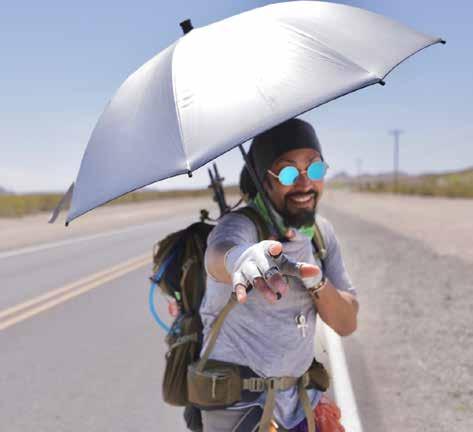
19 Contributed
city-slicker Derick Lugo forfeits comfort to hike the Appalachian Trail.
Perseverance
In 2017, 13-year-old Lucy Westlake walked down all 20,310 feet of Denali, the highest peak in the United States, unable to make a summit bid. After being on the mountain for 20 days, she reached the high camp and was confident in making it, just one night away. But her guides were called on an emergency rescue mission. When they came back, their exhausted, corpse-like bodies were unable to lead a summit push.
Westlake’s mountain climbing journey to Denali really started six years earlier when she was just 7 years old at Black Mountain, Kentucky. While standing at the 4,145-foot summit, Westlake, along with her mom and dad, grew curious about other highpoints, soon researching high points all over the United States. The family planned a road trip the next summer. Westlake summited seven of these highpoints at 8 years old. By the time she reached Mt. Elbert in Colorado, she had a lofty goal: to summit all 50 highpoints. Over the next five years, she continued to inch closer to her goal: the Denali attempt.
“I really wanted to complete that goal,” says Westlake. “I wanted to get it done. It was just so hard not to get an attempt, like if I had just attempted and failed, that’d be one thing, but not even getting to attempt was really difficult.”
Westlake is currently a cross country and track student athlete at the University of Southern California (USC). At 19, she has traveled the world, going everywhere from Alaska to Tanzania, always seeking mountains. Like any childhood passion, Westlake started small. But with each climb came an increase in difficulty, until one day she went well beyond what she ever imagined, reaching elevations most children, or adults for that matter,
could not fathom.
Born in the small town of Eagle Harbor, Michigan, Westlake was raised in an environment where anything was possible. Her first major climbing expedition came at 6 years old, scaling the sixth highest mountain in Mexico, the 14,501-foot La Malinche. This is when she started running, embracing the pain that comes with endurance training. After countless miles and dozens of summits, she earned an athletic scholarship to USC.
“The reason I like doing it isn’t to get to the top and set records,” says Westlake. “That stuff is cool, but what I really love about it is the experience of being in such a beautiful place and seeing the most incredible things and just seeing how incredible the things you can do [are].”
Westlake became the youngest American woman to summit Mt. Everest, which eventually led to her involvement in WaterStep, a non-profit

organization with a mission of bringing safe drinking water to underdeveloped communities around the world. They do this by supplying safe water solutions. Installing an M-100 ChlorineGenerator filter alone can generate 10,000 gallons of clean, fresh water.
“Being able to experience that, seeing it first hand at 13 was really life changing,” she says. “It would just open my eyes. I was like, ‘this is what I want to do for the rest of my life because... it gave them so much hope.”
After a heartbreaking first attempt, Westlake ultimately persevered on Fathers Day of 2021, finally summiting Denali, making her the world’s youngest person to summit all 50 highpoints in the United States. Through her hard work and activism, Westlake received The Billie Jean King Youth Leadership Award in 2022, and hopes to continue making a positive impact.
Climber Lucy Westlake becomes the youngest female to summit America’s tallest 50 highpoints.
20
- Kayla Unrein
Contributed
Purification
The world’s best blue carbon sink, containing an estimated six billion metric tons of carbon, is being strangled by plastic. Pollutants seep into the water and stunt growth, leading to habitat loss for community sustaining fish populations. Red mangroves (Rhizophora) were named after their red wood and are well known for their aboveground prop roots. The spidery roots of the Rhizophora create safe fish nurseries and slowly expand land by collecting sediment.
Devastating effects of colonialism have decimated the hardy plant which currently accounts for only 0.4 percent of the world’s forests and provides protection for an estimated 53,190 square miles of Earth’s surface. Mangroves are the only forest that have adapted to live in saltwater, specifically coastlines, thriving in the loose soil and preventing erosion. For Cameroonian people, a healthy mangrove forest provides food,
medicine, and materials for shelter. Unfortunately, it has been estimated that 35 percent of the Earth’s mangroves have been lost.
For Cameroonian native Achare Elvis Ayamba, natural disasters wreaked havoc through his home, creating a nightmarish cycle of droughts and floods.
Ayamba’s love of nature took him to University of Doula where he graduated with a master’s degree in fisheries and aquatic science. After graduating in 2017, Ayamba started E2F, a nonprofit organization. In early 2018, Ayamba stepped up to clean his city, collecting plastic and planting trees, as well as hosting environmental workshops in indigenous communities.

“When I see, for instance, our environment is very degraded [and] destroyed... The plastic pollution in my community: very alarming. And it makes me sick. And when I step out to look for a solution, getting engaged in collection and doing some work on that, it’s like a medicine to me. That makes me joyful. That makes me hap-
py; That makes me passionate,” says Ayamba.
His organization centers on educating his community, preserving the ocean ,and addressing the dire situation involving our environment. Ayamba’s work incentivizes others in his community to participate as well, thereby hoping to improve the standard of living, especially for youth.
A major focus of E2F is the mangrove forest in Douala-Edea National Park. The park is home to vulnerable species like the black colobus monkey and West African manatee. Unsustainable exploitation of mangroves in Douala-Edea threatens the ecosystem and the surrounding community. Participation is needed to maintain the Douala-Edea project and others like it, but Ayamaba struggles to compete with the draw of white collar jobs. Yet, E2F relies on human resources and Ayamba remains optimistic he can help protect the environment.
Achare Elvis Ayamba protects Cameroon’s environment from plastics with his nonprofit.
21
- Talia Hosford
Alan van Gysen
Community
Author and mother Sabrina
Pace-Humphreys uses trail running to spread awareness.
The trials and tribulations of childbirth affect every mother differently, but for Sabrina Pace-Humphreys it was anything but easy. After having her fourth child, Pace-Humphreys suffered from postnatal depression. Seeking help, a doctor suggested running as a way to clear the mind. Soon enough running became more than just exercise, providing both physical and psychological healing, offering a deeper purpose in life.
As a teenager, Pace-Humphreys found it difficult transitioning into motherhood, finding it hard to manage the responsibilities associated with such a role, eventually falling into early alcoholism and a state of depression. Luckily, running empowered Pace-Humphreys, and she began rac-
ing to challenge her body, seeing how far she could push herself through different distances—5Ks, 10Ks, and eventually ultramarathons.
“I think that it’s when you do something that has purpose, it gives life meaning… The most rewarding part of trail running is understanding how strong your body and mind can be when pitched against the elements and nature,” says Pace-Humphreys. Later, she realized running could bring people together. Growing up in Cotswolds, a rural town in southern England, Pace-Humphreys experienced racism from a young age. Constantly feeling different, she searched for ways to change the environment around her, hoping to create a community with similar interests and representation.
Searching for a way to fight racism, specifically focusing on inclusion in
the trailrunning scene, Pace-Humphreys found inspiration from a running group in London: Run Dem Crew—founded by Charlie Dark. The group focuses on getting people of color into running for physical health and building community. With this in mind, Pace-Humphreys set her sights on a way to bring this same concept to the trail-running world. In July 2020, she helped create Black Trail Runners with the aim to create a safe haven for people of color in the trail running community.
Pace-Humphreys found an escape through the trail running community, overcoming the addiction and trauma that threatened to overwhelm her. She learned she could be a leader and inspire change, finding purpose and providing a model for self-improvement.

22
- Landon Cowan
Contributed
Curiosity
Residing in the School of Journalism and Communication at the University of Oregon, Professor Mark Blaine has immersed himself in storytelling, from editing for Forest Magazine to writing books to exploring kayaking through his documentary, AQayaqtoCarryUs. As a professor, he aims to fuel student curiosity about the worlds of journalism and science. Though in today’s world that is easier said than done, as it seems that the word “science” can sometimes be intimidating.
Making science accessible means tapping into the creative and evoking interest. Recognizing that, Blaine and company explore imagination and interest, where inquiry is applauded in science and curiosity is celebrated.
“I think most people suffer from
not… being curious enough or not motivated enough to push into it,” says Blaine. “But that curiosity, that relentless curiosity, and always sort of checking curiosity, not only in what you see in front of you, but also curiosity about why you see it the way that you’re seeing it, I think is really, really important.”
In many high school settings it seems as if science is narrowed down to three categories: biology, chemistry, and physics. Drilling facts, mulling through labs, and getting lost in rote memorization may result in disinterest. Though science is truly much more individualized and offers millions of ways to dive in.
For example, there are fields within geology and oceanography that one might not find within a normal high school setting but could find themselves truly resonating with. Blaine describes this as finding one’s “hook.”
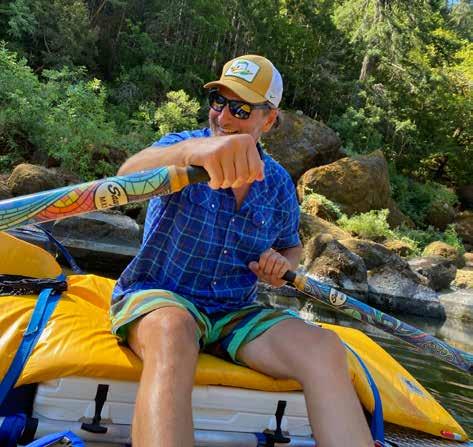
“So this idea of finding a hook for just about anybody into what the excite-
ment, the curiosity, the passion that is at the heart of any scientific endeavor… the world does not present them that way, externally, so much. It’s often sort of impenetrable, obscure, or crazy, like a mad scientist kind of thing.”
Science seems to be this “destructive and uncontrollable power,” especially when it comes to interpreting climate change. One has to look at the subject through a smaller scope, perhaps through a human lens, one shaped around storytelling.
In the Pacific Northwest the past few years, every September we find ourselves indoors and hiding instead of enjoying the last of the sun before the autumn rain and winds emerge. Hiding from thick smoke, red skies, and the even deeper red sun. The Pacific Northwest has been facing catastrophic wildfires that took out 3,736,665 acres alone in 2021. In the past, there was a practice of controlled burning, where the native people purposely lit areas in higher elevation on fire, to help preserve the land. Although in the 20th century this had been outlawed, contributing to the problem now faced every September.
To combat this and make positive changes to our climate, there must be a rise in trust in science, but how can one trust science? Blaine shares, “because you can trust that there’s a community of people who care deeply about whatever the topic it is that you’re talking about.”
Much like anyone can be a storyteller, anyone can get into science, as it is a limitless field. “It’s not a short game, and everyone who wants it at this point should have that opportunity,” says Blaine.
He adds, “if you want to do the thing, and if you’re interested in it and motivated to do it, you’ll find a way to do it.”
UO professor Mark Blaine fuses journalism and science to inspire university students.
23 Contributed
- Kassandra McLennan
Inclusion
As a kid, Lael Johnson often went fishing with his mom and dad, their love for the sport sparking a deep passion in their son. Soon enough, Johnson knew he wanted to be a professional fisherman and spent much of his free time watching animal shows such as Wild America, skipping out on traditional cartoons.
One of his favorite childhood memories came about when he received a fishing rod from his neighbor, hooking a gargantuan fish that he was not strong enough to land. The fight gave him something he hadn’t felt before, and from there on he strived to catch a big fish, and he never stopped searching.
Johnson started his fishing guide
journey 14 years ago as a gear guide.
“I was barbering eggs and pulling plugs and spinners and twitching jigs and all the rest of that,” he says, but the road to becoming a guide had some challenging walls Johnson had to surmount to find success.
¨As you can see I am not your average looking fly fisherman or guide… When I first got in I wasn’t welcomed,” says Johnson. Luckily, he says, “fish don’t care about the color of my skin.”
Halfway through his career, he discovered the beauty of fly fishing, first on the Queets River in Olympic National Park. Johnson was so intrigued that he drifted toward obsession. He liked the challenge that came with learning a new technique.
“You’re starting your whole career over,” says Johnson.
Fly fishing is something that takes a lot of effort. Many people may see it
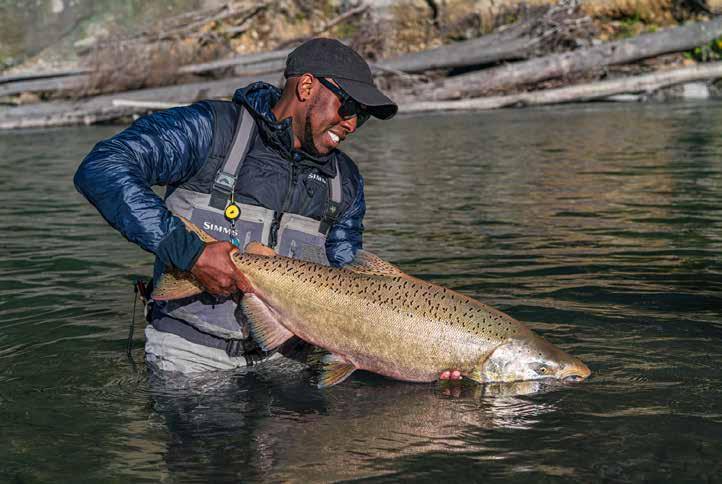
and think it’s some artsy thing, while the reality is that, like most beautiful things, it takes time to perfect: lots of it.
Beside seeking the perfect cast, he has other goals. His foundation, For Your Sanity and Happiness (FYSH), is designed to expose people to the sport he loves, opening the doors to minorities and giving them the opportunity to be outdoors and free of judgment.
Johnson’s paramount goal with being a guide does not have to do with fishing but rather being able to open doors for people of color. He wants to make people feel like they have an opportunity and that they don’t have to stop or let people talk them down because of the color of their skin. They too can have a dream start by hooking on to a big fish and wanting to chase that feeling.
- Bryan Lomeli
24 Contributed
Lael Johnson uses his role as a fishing guide to inspire people of color to chase their dreams.
Empowerment
Red Bull mountain biker
Hannah Bergemann helps pioneer women’s freeride biking.
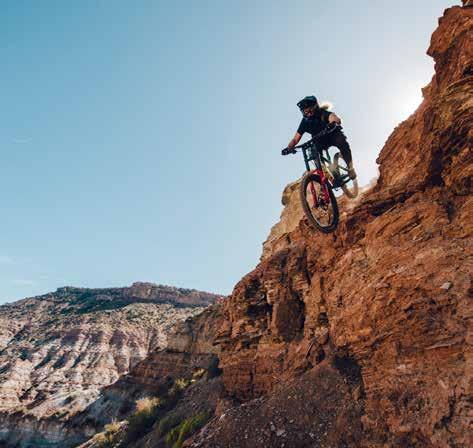
Hannah Bergemann grew up vacationing to Mt. Hood, where she was immediately drawn to the high risk world of freestyle sports. Gliding across rails on her skis eventually transitioned into racing across the forest floor.
After growing up in Portland, Oregon, the Bergmann family moved closer to Mt. Hood, where she began to ski competitively at the age of 10. She didn’t care much for the competition but loved seeing the ways in which she was able to make progress and get better. As a junior in high school, Bergemann received her dad’s old mountain bike as a gift and started bombing down trails around Mt. Hood. Passion quickly took over, and Bergemann was intoxicated with the speed, jumps, and the risk of danger.
When it came time to pick a col-
lege, one of Bergemann’s biggest deciding factors was the opportunity to mountain bike, eventually deciding on Western Washington University in Bellingham where a vibrant community of bikers further lit a fire. While working on her bachelor’s degree in kinesiology and Spanish, Bergemann familiarized herself with the lines, harsh and unforgiving, of trails surrounding the city,
“It’s hitting lots of drops and jumps and then like techy, gnarly, rocky, wood and stuff like that,” Bergemann says about conquering the trails. “A lot of really steep stuff.”
Bergemann moved to Bellingham with the intention of pursuing a career in medicine, but in 2019 she was invited to the Red Bull Formation event, founded by Katie Holden. It was the first women’s freeride session.
After receiving a call from Holden,
Bergemann booked a flight to Virgin, Utah in October, having no idea what she was getting into when she landed with five other athletes. She spent time with five other women digging lines and trying new features. “It really was kind of like where my freeride career took off,” says Bergemann.
Her goal for this newfound career was to create space for the next generation, be a good role model, and help grow the relatively new sport, which lacked female representation. Not having anyone to look up to, unlike her male counterparts, was one of her biggest obstacles. The inadequate support for women in the sport meant Bergemann was only one of a few women riding, until recently.
Inspired by the Red Bull Formation event, Bergemann set up an annual women’s riding event in Bellingham called Hangtime. About 30 women with varying levels of expertise were invited to join her at the Blue Steel jump trail, a line that she helped to build. Over two days, they built a groundbreaking, inclusive place for people who otherwise wouldn’t have one.
“Throwing huge airs and big tricks on the jumps with style and control, some of the riders [were] as young as 12 years old and they’re hitting 40-foot jumps on their mountain bikes in front of a big crowd,” says Bergemann.
Outside of riding trails, Bergemann works for a bike shop called Transition Bikes, riding on their factory team. Her role mostly consists of media projects, attending events, and marketing.
“I love having that connection and getting to learn from everyone because I think everyone has their own talents and skill sets,” she says.
More than anything, Bergemann works to create a better space for women in the next generation of freeride bikers, hoping to ignite their respective sparks of passion. - Courtney
Brown
25
Paris Gore / Red Bull Content Pool
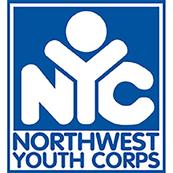










Sponsors We Would Like To Thank Our Partners SCHOOL OF JOURNALISM AND COMMUNICATION ENVIRONMENTAL LEADERSHIP PROGRAM Any Extra Information and dedications here We Would Like to Thank Our Partners Special thanks to Best Friends Forever, Infinity Nails, Papa’s Pizza, and Springfield Rentals for sponsoring the MINE program.
Designing per formance outdoor and athletic clothing in Eugene since 1985.
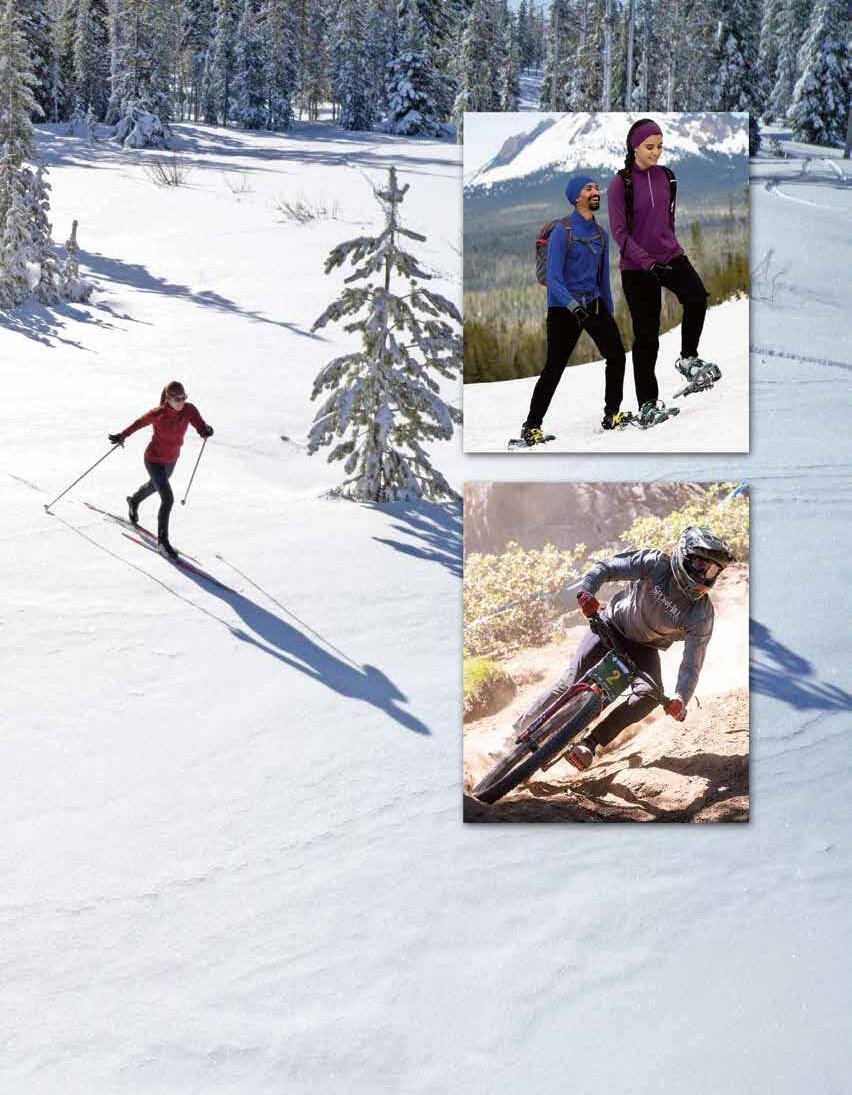
Worn by Olympic Champions and outdoor enthusiasts nationwide.
Available at Berg's Sk i Shop, at our company store, and online at spor thill.com

A Melting Reality
Photographer Donal
works diligintly as he documents the decay of glaciers and the impact of climate change on rising sea levels.
In 2016, photographer Donal Boyd left Boston, Massachusetts to move to Iceland for its natural beauty, only to discover the landscape was disappearing. After six years in Iceland, Boyd decided to work with cinematographer Frank Nieuwenhuis to create the documentary In a State of Change. They used photographs of Icelandic landscapes and glaciers from the past and compared them to present day photographs to show the relationship between humans and ever-changing landscapes affected by climate change. Since the industrial period—around 1850— scientists have observed the long-term heating of the Earth, collecting data on humans using fossil fuels that trap greenhouse gasses in the atmosphere. Climate change is the long-term change in global, regional, and local weather patterns, but unfortunately there has been little to no action to combat it. The greenhouse effect occurs when sunlight reaches the Earth but only some of it is reflected back into space, then some of it is absorbed into the atmosphere, and once absorbed by greenhouse gasses it radiates in all directions, increasing the global temperature. This increase in global temperature has caused many glaciers and ice caps to melt, which in turn slowly initiates a rise in sea levels. As these levels gradually increase, coastal cities could soon be submerged in water, causing a loss of homes and displacement for many.
Countries covered with ice sheets are melting at a fast rate. For instance, Greenland is losing 267 bil-
lion tons of ice per year while Antarctica is losing 150 billion tons of ice. Both are contributing to the rising sea levels. According to the World Glacier Monitoring Service, 2020 was the 33rd year in a row that mountain glaciers around the world have experienced a loss of ice. Since 1970, the cumulative glacier mass has declined by 27.5 meters (90.22 feet) per glacier. Glacier expert Mauri Pelto had declared that the glacier loss pace between the 1980s and 2019 had been accelerated by approximately 2.34 feet.

Boyd’s goal is to engage people in a meaningful way. Rather than posting a photo on social media with some simple caption, he wants people to gain a deeper understanding of where negative indicators—droughts, wildfires, and extreme weather—are leading us. In the documentary, Boyd interviews a glaciologist, Dr. Finnur Pálson, who explains that if the glaciers in Iceland melted it would cause a one centimeter increase in sea levels. If this were to happen, that would indicate that other glaciers would have melted in places like Greenland, and Dr. Pálson says that the sea levels would rise almost six meters (19.68 feet). Dr. Pálson ends his interview by mentioning, “it is a global problem, not an Icelandic problem.”
Given the choice between moving to Minneapolis, Minnesota to continue her corporate career or taking


29
Lucas Paugh Donal Boyd
Boyd

30
Donal Boyd travels through Iceland for his documentary.
a severance package and exploring the world, Jennifer Marlon decided on the latter. During her travels to Australia, New Zealand, and Indonesia, she found a passion in nature and began rethinking things, asking questions like: “Why [do] the plants and animals in New Zealand look like the ones in Oregon and [other] places in the Pacific Northwest?” Her inquisitive personality led her to graduate school at the University of Oregon, and she eventually came to the conclusion that geography was a good fit, allowing for further questions about local and global geography.
Now a Director of Data Science at the Yale Program on Climate Change Communication, as well as a Senior Research Scientist at the Yale School of Environment (YSE), Marlon is raising awareness about the climate crisis. As a part of her dissertation, she built the framework for the Global Charcoal Database: a way to share fire and charcoal research globally and locally. As a result, dozens of her colleagues helped fill in the gaps with their research. While working on the framework, she noticed that some of her labmates were doing specific research on lakes and watersheds but not comparing their data with others regionally or globally.
“Because fire is partly driven by climate changes, and they have some kind of global signature, then we should be able to see similar changes in fire regimes all around the world, to some extent,” says Marlon. Her goal in creating the Global Charcoal Database was to have a way to compare data from all around the world, so experts can start looking at it as a “planetary phenomenon,” instead of a large assortment of independent events.
Marlon has also shifted towards examining the social science side of climate change. She says, “I feel like we actually know quite a lot about the physical and natural changes, and now the real problem is social.”
Her focus is on trying to understand and figure out why people are not understanding the risks of climate change; she tries to answer the basic questions, such as what, how, and why? Climate change can come across as threatening and hard to understand for people who are new to the topic.
Marlon is trying to help people understand one specific question: “How can we do a better job of explaining that climate change doesn’t just threaten the sea level of coastal cities? It threatens the economic stability of the world and threatens our food systems or supply chains. You know, if the airports in New York
go underwater, that doesn’t just affect New York.” If people become aware of how connected everything is, understanding certain interdependencies, then they may be better prepared to fight against climate change, and perhaps act with more urgency.
Boyd suggests the purpose of the film was to connect people to the landscapes of Iceland in hopes to better communicate the climate change dilemma. In the film, he traveled with a guide through a glacier cave, Breiðamerkurjökull, only to discover that it was predicted to disappear the following year. Boyd believes that creating deep emotional connections with our surrounding environments is important to creating the protective reactions needed to preserve those environments.

At one point, he interviews Laufey Lárusdóttir, a woman who helps illuminate what has been lost. Much like Boyd is trying to achieve, she has her own photographs of the glacier from when she was a child, and it had an important use to the community and necessities for families. She shares a quick story of when, as a child, she crossed over the glacier to pick berries, but now all that is left is a faded memory. She says, “I find it sad to look at the glaciers now and see how tiny they are.”
The community used it for travel and resources, but the receding glacier is making it harder for newer generations to form the same connections to their surroundings that their ancestors once did. Boyd knows that the Icelandic landscape will never be the same. He says, “I love it, and I hope that other people will love it, and I hope that other people will connect with that, and hopefully they can understand.”
Boyd, like Marlon, wants to find the right way to express the need for urgency in combating the climate crisis. With the hundreds of news articles coupled alongside scientific papers and outcries of doom, sifting through the constant outpoor of information is difficult and taxing. InaStateofChange offers a visual explanation that makes the drastic changes that have already occurred easier to comprehend. With passionate people like Boyd using their abilities and social platforms to spread awareness, and with help from scientists like Marlon answering important questions and providing critical research, people can better learn how to live with hope in the face of climate crisis.
 -Original reporting by Grace Paugh & Tamerra Cervantes-Carlos
-Original reporting by Grace Paugh & Tamerra Cervantes-Carlos

 Bridget Franek runs in the 2012 United States Olympic Trials at Hayward Field.
Bridget Franek runs in the 2012 United States Olympic Trials at Hayward Field.
Steeplechasing Dreams
World class steeplechaser Bridget Franek defies her limits in a famed Olympic competition.
The deafening cheers of the crowd at the 2 012 Olympics filled the ears of professional steeplechaser Bridget Franek. She had spent years training for this very race, but even still, half of track and field is mental, and you can only train so much. If she wanted to perform at her best, she would have to overcome her anxiety and run against some of the best athletes in the world. Thousands were watching her event in the stands, millions more on TV, all waiting for the sound of the starter pistol, marking the start of the race. Years of training has led up to this very moment, all to be decided in a few short minutes. The shot fired, commencing a fight between 14 athletes from around the world, only one of them coming out on top. But Franek had already reached her pinnacle.
Franek began her journey in high school, where she first discovered steeplechasing from her father. Competing in soccer in the fall and basketball in winter, she needed something new to fill her off-season, looking for something different.
“Steeplechase added an element of skill
and technique… more exciting than just running circles around the track,” she says.
Unfortunately, Franek soon learned that her steeplechase career would have to wait, as only a few states recognized the event at the high school level. She had to hold off competitions until college. Once college arrived, her coach allowed her to try out for steeplechasing, eventually sparking a life of professional athleticism.
Her first experiences with steeplechasing were prestigious, to say the least. She became a bronze medalist in NCAA’s 2008 steeplechase and later became the national champion in 2010. While Franek’s college achievements were enough to make her mark in steeplechase history, she still strived to push herself to her utmost limits.
After graduating from the University of Oregon, Franek continued to compete in events, each larger than the last. She started competing in the USA championships which would later pave the way for her career as a world-class athlete. She began traveling to Diamond League events, races scattered across the planet to test herself
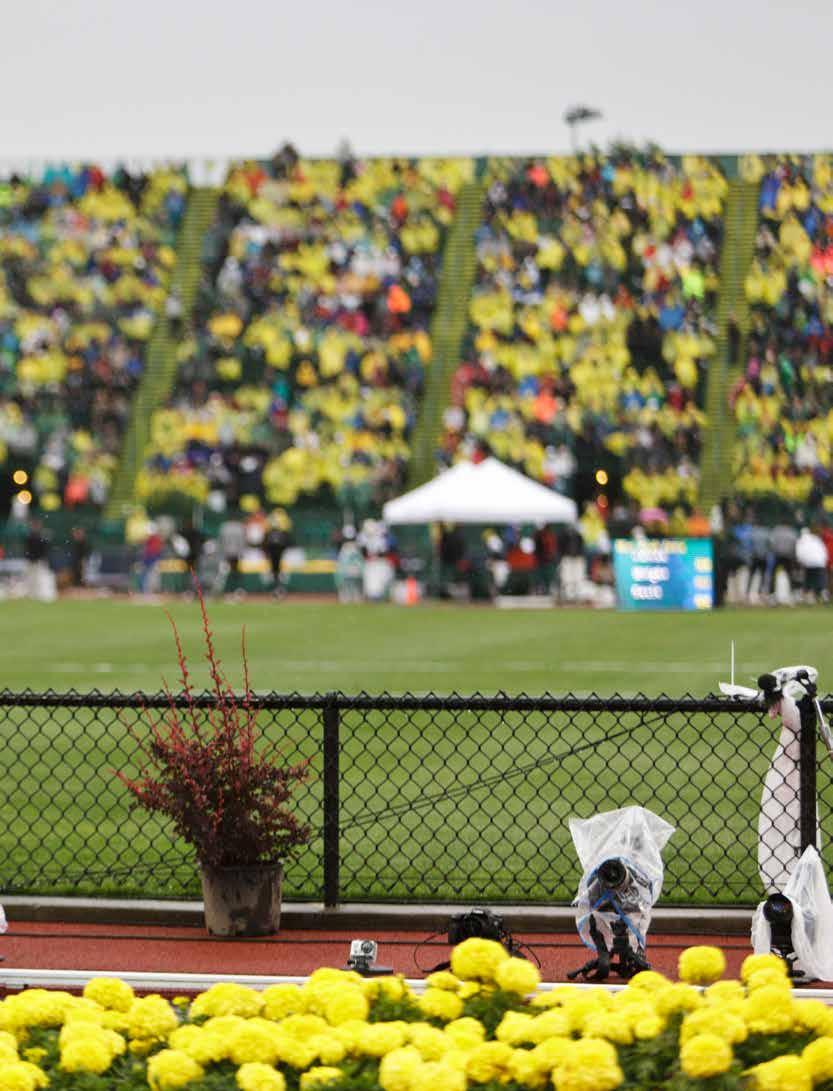

33
Kevin Morris Kaden Hurley
against the greatest runners on earth. After five years of competing in cities like London and Stockholm, she was finally invited to the Olympic trials, where she would compete for her spot on the team. In 2012, she placed second, which later resulted in rigorous training with the Olympic team.
Joining the Olympic team meant enduring some brutal training, 75 miles a week, sometimes up to 14 miles a day, training at over 7,000 feet of elevation.
“When you run at that altitude it feels like you are breathing through a straw,” says Franek.
This not only tested her physically, but mentally as well, fighting anxiety and selfdoubt throughout the process. She was surrounded by some of the best athletes in the country, if not the world. It felt as though she was “being thrown into a group of athletes that were at a much higher level.”
but it definitely doesn’t.”
This was an extremely emotional experience for someone so devoted to their event. Franek had reached the biggest stadium steeplechasing has to offer. It wasn’t until the opening ceremony that she truly recognized the brevity of the experience.
She explained, “I knew going into the race that I would have to run the best that I’ve ever run before.”
Franek already knew the odds were against her winning an Olympic medal, with many of the athletes training their entire lives, but she still wanted to make it to the finals. To make it through preliminaries, she pushed herself to the utmost extremes, fighting to keep her position in the race.
Franek
Already struggling with harsh training, there was one more challenge she had to face. For the majority of Franek’s events, she found sponsors to cover costs, but steeplechasing is a time-demanding sport that makes maintaining a job nearly impossible, and the Olympic team offers very little in terms of money.
“We don’t get paid like football players or basketball players,” Franek explains.
She needed to find another way to finance Olympic training and events. After a long period of stress, Franek discovered a solution, a race called the Warrior Dash World Championship, a rugged course full of mud and rope obstacles and steep terrain with a $30,000 prize for first place. Franek seized the first-place title, securing the money, and continued on her Olympic path.
Franek was a professional steeplechaser for 10 years before making the Olympic team, training non-stop to become one of the best in her event. Even still, preparation can only go so far.
She says, “it’s the same race that you’ve run a million times, it should feel the same,
Though thoroughly exhausted, Franek managed to claim fifth place and advance to the finals. Completely drained, she competed in the finals, reaching 14th place, leaving her with mixed feelings of embarrassment and pride. Even still, she could claim to have competed at the peak of track competitions, ranking 14th in the world at women’s steeplechasing.
While Franek was distressed at her performance in the finals, it was still one of the most incredible experiences she had gone through in her life.
“And to think that there are millions of people watching was [emotional] and hard to wrap my head around,” says Franek. “But I was so proud of myself for doing what I could.”
Today, Franek tries to maintain a similar training regimen, which, while not as arduous as before, still affords fitness.
Even after recently having a baby, Franek is still able to run multiple times a week, for around five miles a time. She enjoys trail running and is hoping to join a trail race this year, time permitting. While her competitive days might be over, they remain the most intense and thrilling times of her life. She had to face powerful athletes and intense training, and even still, she never gave up.
35
34
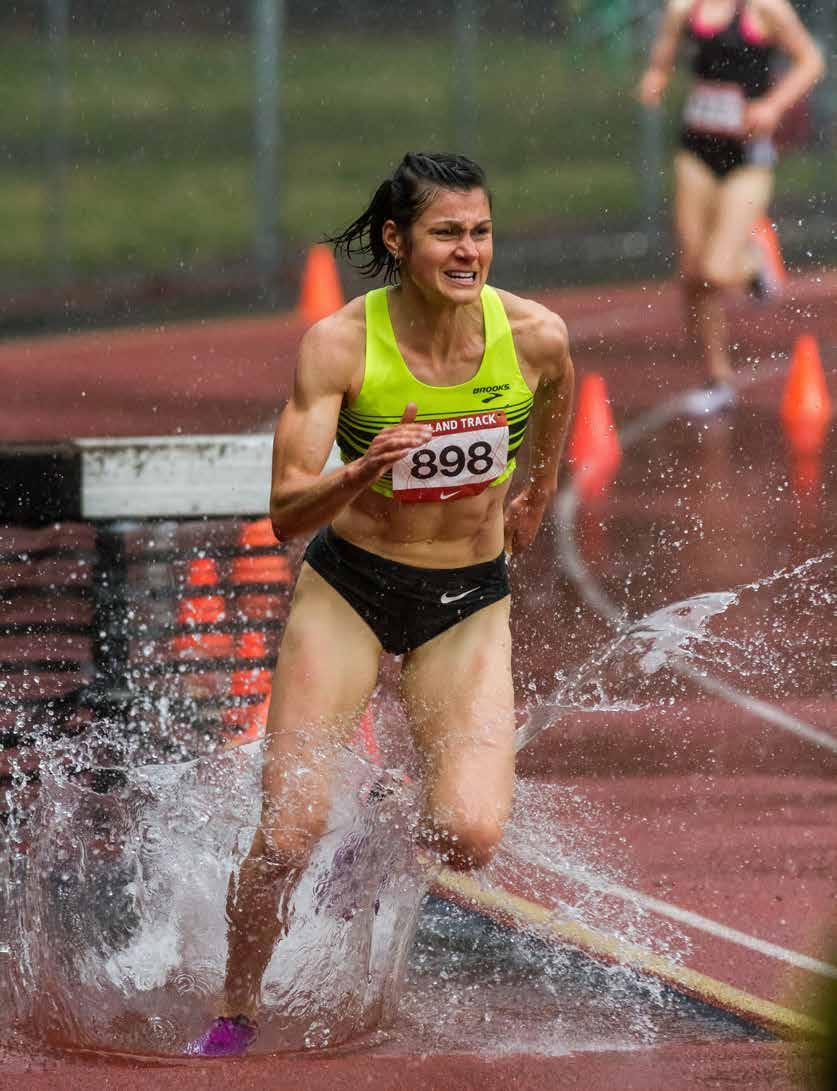
35
Bridget Franek splashes her way through the water pit barrier.
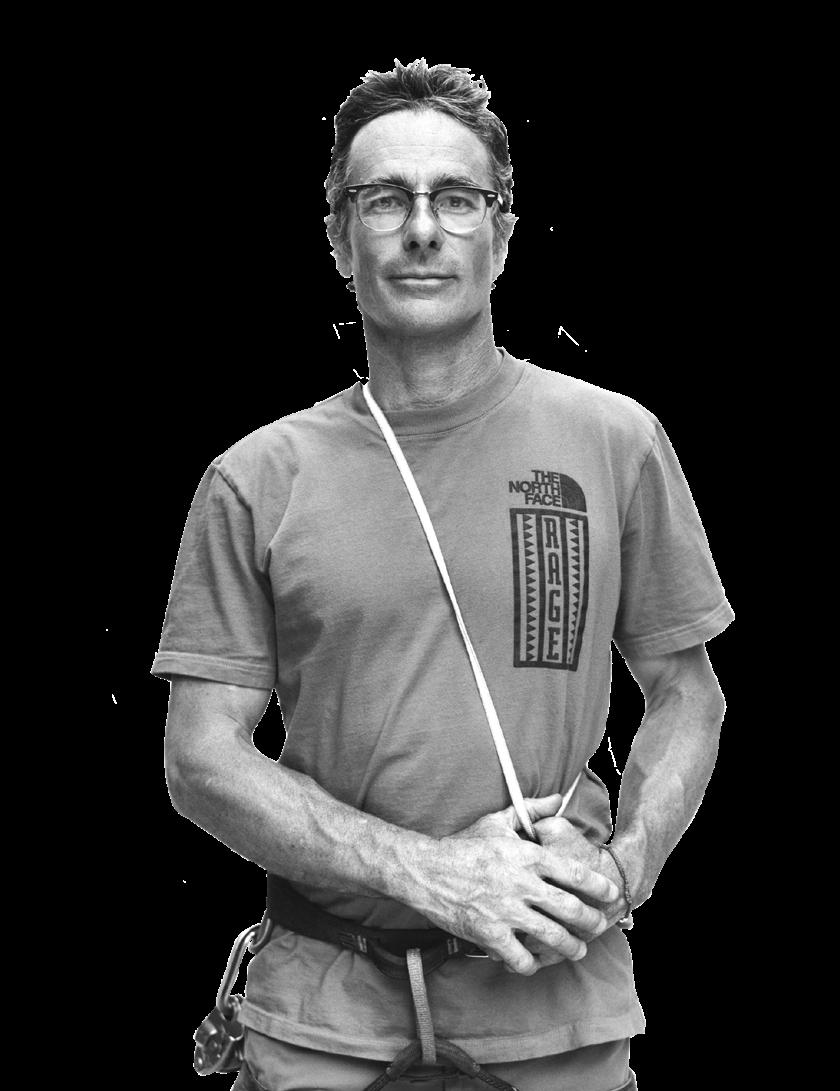
 Cedar Wright poses for a photoshoot with The North Face.
Cedar Wright poses for a photoshoot with The North Face.
The Dirtbag
Climber
Back in 2016, climbers Alex Honnold, Maury Birdwell, and Cedar Wright traveled to Kenya in east Africa with one goal: summit Kenya’s largest mountain wall, Mt. Poi. Met with agonizing heat, the trio had no choice but to wait for midday, when the temperatures would be lower and the ascent more feasible. The challenge: by noon, they had barely five hours of sunlight to utilize. The race against time was on. Drenched in sweat, they pressed on, with determination etched into their skulls. As the last light sank below the horizon, the illumination dissipated, forcing them to resort to head lamps. Whilst juggling the new lighting situation, the ascent growing in difficulty, they pushed to the top of Mt. Poi. The three had just climbed over two thousand feet drenched in an oppressive veil of darkness, a feat only a trio of dirtbags could manage.
As they departed from Mt. Poi, they laid their eyes upon the Nkadorru-Murto (also known as the Cat and Mouse), three climbing walls that they were eager to get their hands on, and so, they agreed to set up camp. Wright and Birdwell drilled in hooks and anchors over the span of the following two days. As Christmas rolled around, the trio began their ascent of yet another large natural structure. The story of this climb concluded the same as the last; the dirtbags conquering another wall. Yet, Wright remained unsatisfied. He wanted more. No, he needed more.

Mt. Kenya, the second highest mountain in Africa at over seventeen thousand feet, would be his next goal, and he was going to free solo it. Free soloing is often cited as the single most dangerous form of climbing ever. No ropes, harnesses, or other safety equipment. Unlike bouldering (another form of climbing free of safety equipment), climbers scale walls well above any sense of safety, meaning even the smallest mistakes prove fatal. His heart beating with anticipation, Wright began his ascent, and with much tribulation, reached the summit. Yet another meal for the dirtbag’s insatiable lust for thrill. Instead of finding a way to climb down, Wright used his paraglider. Or as Wright likes to call it, “my magic backpack.”
Dirtbag, a term some might guess is a playground insult akin to “meanie,” truthfully means something entirely different. A dirtbag is someone who dedicates their entire life to the world of the outdoors. A dirtbag’s mindset drastically differs from that of a non-dirtbag. A dirtbag and a non-dirtbag will see the same forest, mountain, lake, etc. and have a vastly different outlook. A non-dirtbag will see a lush mountain wall and be able to appreciate the stunning natural beauty, but a dirtbag’s appreciation phase ends abruptly as they quickly grab their climbing equipment.
TheDirtbagDictionary defines it this way: “a person who dedicates his or her entire exis-

 Drew Campbell Miguel DeLeon
Drew Campbell Miguel DeLeon
37
Cedar Wright exemplifies what it means to be a dirtbag while making first ascents across the world.
tence to the pursuit of climbing, making ends meet using creative means. A dirtbag will get her food out of a dumpster, get his clothes from a thrift store, and live in a tent or vehicle to save money. Often found living near major climbing destinations, the dirtbag is a rebel with a cause who finds happiness in nature. When the dirtbag grows up (if ever), he or she often is drawn to a profession engaged with the outdoors and/ or creative arts.”
To put it in Wright’s words: “A dirtbag climber is just somebody who lives very simply so that they can climb all the time. For me, that meant in Yosemite living in caves, living in my tent, living out of my car… so that I could climb. That’s kind of the spirit of the dirtbag.”
Wright’s dirtbag origin story began in college, where he went for creative writing in northern California. “I saw people climbing on cliffs,” he explains. “I saw people climbing and I just thought it’s the craziest, coolest thing.”

Soon enough, Wright got in touch with a friend of a friend, who took him for his very first climb. “It was for me the first time in my life where I really found something I was truly passionate about,“ says Wright. “I was just totally hooked and that’s all I wanted to do after that.”
Wright explains arguably one of the most important aspects of being a dirtbag climber comes down to who’s involved. “You know, a partner is everything,” he says. “You’re really only as good as the people that you climb with, and it’s a weird thing, but you can really feel the energy coming through the rope. So if you’re always with somebody who really believes in you and wants you to succeed and really has good, positive energy, I believe you can really feel that through the rope.”
Wright’s climbing career led him to meet an invaluable partner in 2007 in Yosemite: Alex Honnold, a legendary climber and certified dirtbag, best recognized for his free soloing of large mountain walls. It soon became apparent that the two made quite the perplexing pair. Honnold is a man in his thirties with a strict commitment to training and staying in peak physical condition. This includes staying away from alcohol and other distractions that disrupt the dirt-
bag creed. Compare this to Wright, who is in his forties and never shies away from being the life of the party. In fact, “never shies away” undersells it. He finishes his training days with some pizza and a beverage of his choosing. At the time of their meeting, Honnold was only beginning to gain notoriety, while Wright had been on The North Face team for five years. Despite the glaring personal differences, their opposite natures complimented each other perfectly and they soon formed an inseparable friendship.
A notable example of their teamwork took place back in 2017. The dirtbags found themselves in Antarctica on one of their usual climbing adventures. The weather was fierce, and the impending ascent was bound to be fiercer. Skiing across the glaciers, searching for climbing spots, they came upon a large, tower-like structure of ice. Honnold, usually the leading type, found himself feeling nervous. He wasn’t going up unless Wright led. Wright was determined to save the expedition by any means possible. Wright found himself scraping snow off ledges and facing the fear head on. Not even the worst Antarctica weather was enough to deter the dirtbags.
This is why the partnership works; they simply work together at all costs. In many ways, they are diametrically opposed, but when it comes to the climb, their minds simply click, an underlying passion for climbing driving them both. With a copious amount of trash-talk, Honnold will push Wright, and Wright will push Honnold. And together, they’re unstoppable.
The life of a dirtbag isn’t one built on quitting, but rather one built on overcoming adversity, where getting knocked down immediately precedes getting back up again. For dirtbags like Wright, this is the dream. “For me, climbing is a meditation,” he says. “You’re just losing yourself in the movement and you have the experience, the adventure, and it’s a way to shut off the monkey line and just be present in the moment. That’s one of the things I love about climbing.”
This is the life of a dirtbag, one of commitment, challenge, camaraderie, and most of all, fun. And Wright wouldn’t have it any other way.
- Original reporting by Sydney Sattler
38


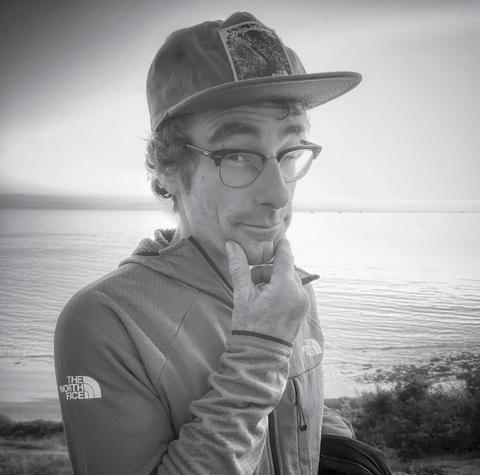
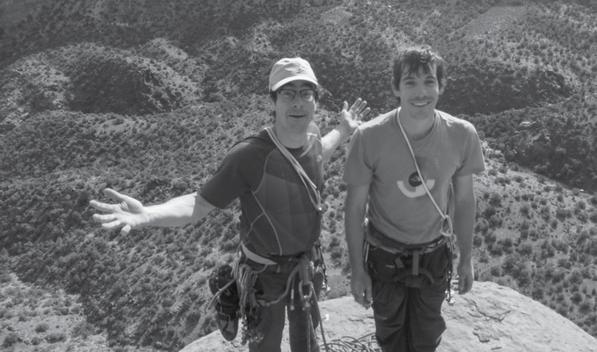


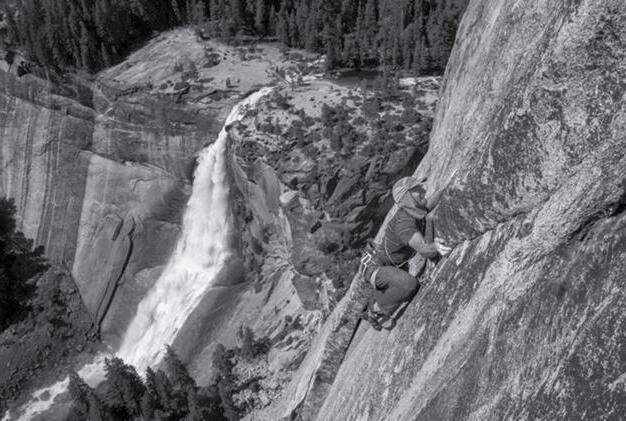

40
Growing with Nature
Writer Amanda Arch
reminisces about her outdoor education and its value in today’s urbanizing world.
 Amanda Arch Koda Mihm
Amanda Arch Koda Mihm
It’s still dark as I leave my home, pajama pants dragging on the floor, blanket draped around my shoulders. My mother opens the car door for me, telling me to hurry up, repeating the fact that she’s going to be late. I watch sleepily out the window as our suburban neighborhood turns into long stretches of empty land, peppered with houses, barns, and animals. We drive along the river, and I want to swim in its waters, but I know that it is much too cold this early in the spring.
While my siblings sleep before school, the world out here is awake and blooming with life. Cows graze slowly on the long grass. Horses whip their tails and stamp their hooves into the earth. A few tractors kick up thick clouds of dust out in the fields. We reach a hill, my mother’s ancient car climbs and spouts boisterous noises of protest. The gravel crunches beneath the tires, and I unbuckle my seatbelt so that I can see the beauty of the land more clearly through the windshield.
As we approach my grandfather’s large green barn, I spot a few turkeys and quickly roll the window down. I smile to myself as they gobble, bouncing away quickly in a little pack. Finally, we reach a long iron gate, sealing off the long road from my grandmother’s gravel driveway. My mother stops the car and I jump out, running in my slippers up to unloop
the chain that holds the gate in place, and with every bit of strength I pull it open, just wide enough for my mother’s car to slip through.
My grandmother stands on the front patio under the gazebo, a pale blue mug clutched in her soft, wrinkled hands. She greets me with a hug. The exchange is quick, and before I know it I’m waving goodbye to the old little car as it disappears down the road.
I follow my grandmother inside. A fire roars in the wood stove, and Grandma begins pulling pans out of drawers in the kitchen. She beckons me over and I quickly make my way to her, taking my place on the wooden stool so that my arms can reach above the countertops. I beat eggs and butter toast as Grandma works swiftly over the stovetop. Before long, the table is set with three plates.
I open the door to my grandfather’s office, noticing the large bookcases that cover the walls. Some books are worn and tattered with stained pages and creased covers, while others are pristine and neat with vibrant spines and gold-foiled titles. I tell my grandfather that breakfast is ready. The three of us enjoy breakfast, but the sun quickly rises in the sky, meaning there is work to do.
Once dressed, we head out the door. I grab a large metal pail, reeking of leftover food–corn cobs,


41
melon rinds, an apple. We enter the muddy fields and my boots slowly sink into the wet ground. We reach into the pail and throw chunks of rotting food. When the pail is empty, my grandma asks me to count the cows. I nod my head and climb a few rungs of the rusty metal fence to get a better view. I count slowly, moving across the field in a grid, being sure not to count the same cow twice. I count 24, and my grandmother congratulates me.
Later, she kneels next to me and points at a small batch of tomatoes hidden under the vines of their own plant. They are small and green, nowhere near as ripe as I know they should be for the season. Before she has to speak a word, I gently brush the protruding vines out of the way until the small batch of tomatoes lays in a ray of sunlight. I know that without light, they will end up at the bottom of the slop pail. That is, as my grandmother says, “the natural circle of things.”

far outnumbered the elite. Schooling was not commonly offered to children of impoverished families, and even if it were, many families may have chosen to decline the offer, simply out of necessity. Most impoverished families helped fill blue collar jobs, such as carpentry, blacksmithing, and farming. It was these families who desperately needed help with working, and the best place to look for cheap labor was children. Instead of being sent through formal schooling, children were taught important manual skills by their parents or older siblings: their classrooms oftentimes among the crops. Learning was a secondary need, and therefore took its place in small increments, and was often woven in with work experience. Slightly older children may be taught to read by an older sibling during lunch breaks. And older children observed science through the lens of their own farm and its inner-workings. While this style of learning is most definitely different from that which children experience today, there are many reasons to look to the past and take inspiration from this learning style when considering the academic wellbeing of our own children.
It is of no surprise that humans have moved away from the realm of outdoor learning as a way to educate youth. Since the Industrial Revolution the world has changed dramatically in order to adapt to the industrial way of living, and the new technologies that came with it. Eventually, there was no longer the appeal to grow or produce food, seeing as a mass market grocery store around the block could provide those same foods without any of the effort. Humans stayed inside more, and it is here where our world would see one of the largest frameshifts in culture as a whole, especially in the realm of education.
Before the industrial age of mass-production, it was uncommon for children in the 18th century to attend school. Before, academic schooling used to be a privilege of wealthy living, an opportunity that only the rich were granted. Many middle-class children in the 18th century were commonly provided with tutors for all academic purposes.
Education looked very different for poor children, however, despite the fact that the lower class
Many cautious parents and skeptical educators have discouraged the idea of reinstating nature-integrated learning, claiming that it will have a negative impact on the academic wellbeing of our nation’s students. Yet, this idea is not strongly supported through evidence, and in fact, many scientific observations and studies support nature-integrated learning, outdoor schooling, and the benefits that come with it.
During a study on the “Effects of Outdoor Education Programs for Children in California,” conducted in 2004 by the American Institute for Research, scientists observed and monitored the outdoor schooling of 255 sixth graders compiled from four different Californian schools during a three-month time period. Not only did the scientists observe the group of students in the outdoor learning program, but they also handed out frequent surveys to both the outdoor school group as well as a control group of the same number of sixth graders from all four of the same schools. These surveys questioned the children on their feelings of self-confidence, cooperation, and conflict res-

42
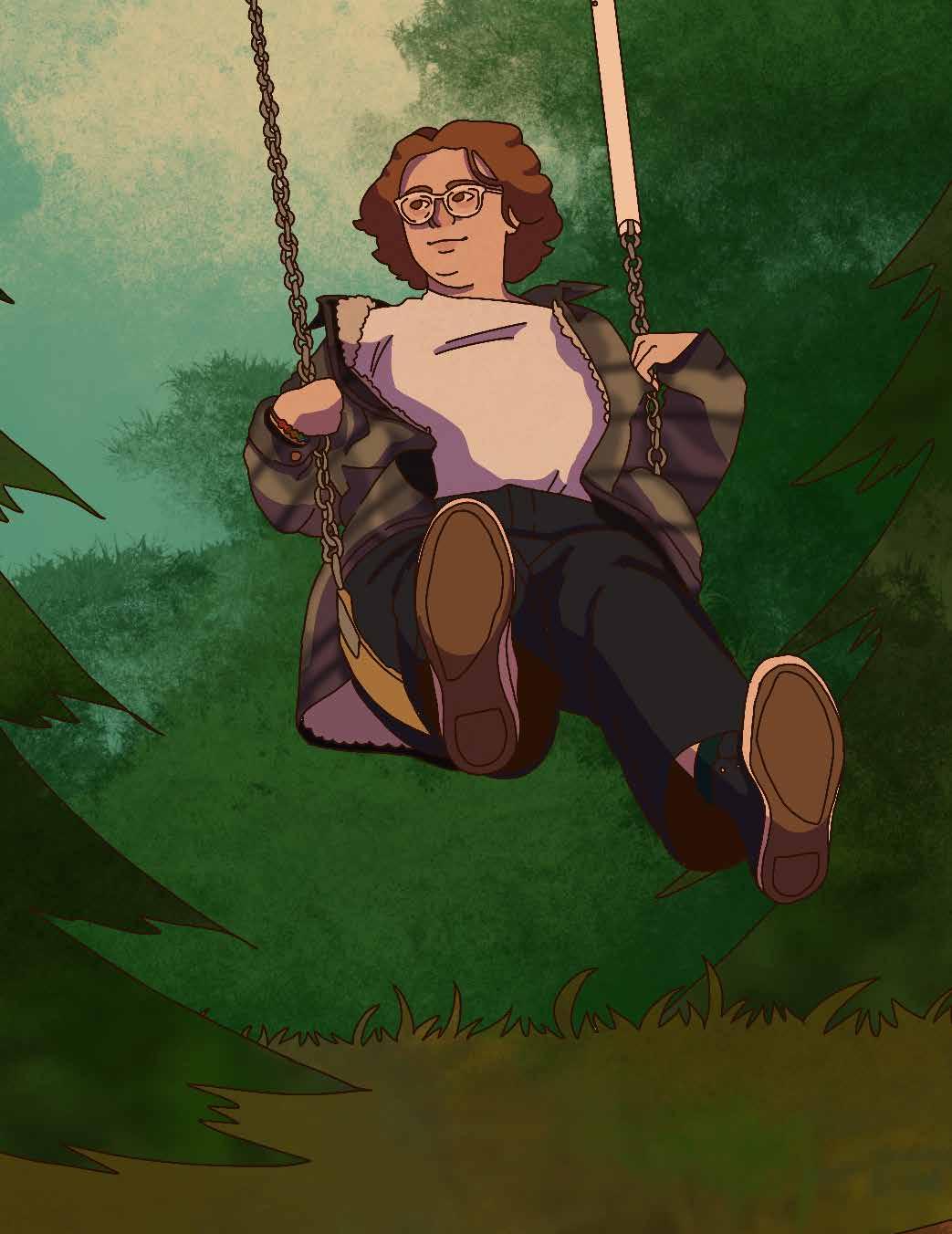
43

44
olution skills. The results, shockingly positive, observed plenty of reasons to make the steps towards reinstating outdoor schooling methods.
In the new age of technology, students struggle now more than ever to maintain a sense of high self-esteem. With an abundance of online influences around every corner, children seem forcefed societal ideas of an ideal beauty standard. Young people feel increasingly more insecure, putting them at risk for mental health disorders such as eating disorders, anxiety, and depression. When compiling the results of the student surveys for their outdoor school study, the American Institute for Research proudly presented an increase in self-esteem levels for the children that participated in the outdoor learning experience. Within just three months of outdoor schooling, the children experienced an increase in self-esteem of 9.65 percent. This growth compounded over time, and as the children continued through their outdoor studies, many of them experienced an increase in self-confidence as well.


Additionally, the results of this study produced extremely impressive results regarding the conflict resolution skills of the students involved. Between the months of September and November of 2004, the students that participated in the nature-integrated schooling experience developed a 6.5 percent growth in their conflict resolution skills. The data is extra encouraging when placed next to that of the control group students, who actually saw a decline in their conflict resolution skills by 8.33 percent. This means, upon survey completion, there was a total difference of 4.3 percent in conflict resolution skills between each group, in favor of the treatment group, when compared to the pre-survey difference of -11.5 percent. The treatment group clearly improved, where the control group deteriorated.
It’s important to take a deeper look at why nature-integrated learning is so effective at promoting life skills in children. The biggest aspect of change in learning came in a drastic shift in environment. While the students received a very similar curriculum to what they had been seeing back in the classroom, they were placed in a much different environment. In a traditional classroom, every aspect of the learning environment is controlled, from the fluorescent lights, to the uniform desks and chairs, all the way down to the similar learning style that is pushed onto every student, whether it supports their success or not.
One final important result observed in the study was the growth in students’ concern about conserving nature. In a time when resources are being depleted, protecting natural areas may provide a sense of human fulfillment. The group sent to the nature-integrated schools experienced an 8.28 percent growth in regards to their concern about conservation, compared to the -1.14 percent depletion seen in their control group counterparts.
I am grateful to have had an outdoor education. Not only did I get to learn in a way that helped me succeed, I gained a sense of self confidence. Most importantly, spending countless hours outdoors exposed me to the wonders of nature and made me more passionate about wanting to keep it safe. While still enrolled at a typical American school for the entirety of my childhood, I spent springs and summers out on my grandmother’s farm. This balance allowed me to learn how to coexist and thrive in an environment with my peers. However, I also experienced times out on the farm where I was secluded and had to rely on myself to succeed. Both of these scenarios allowed for immense growth, both academically and personally, and maybe this is what society needs to advocate for, more balance.

45

46
Bouwman Blood
When thinking of an outdoorsman, most people would probably think of someone like the Clif Bar mascot, online hiking influencers, maybe even a buff Australian man comes to mind. Whatever you may picture, forget it. Replace that image with the worst outdoorsmen you’ve ever seen, overweight, clumsy, excruciatingly loud, scaring away all of the wildlife in a 100-mile radius with every step, the sound of laughter booming through the treetops. I’d love to say that’s the description of the guys 50 feet away from us (truly, I would), and this is some sort of “here’s how not to treat the great outdoors” story, but unfortunately there are no guys 50 feet away from us, and this isn’t some some sort of “here’s how not to treat the great outdoors” story. To the contextually challenged, yeah, that’s us.

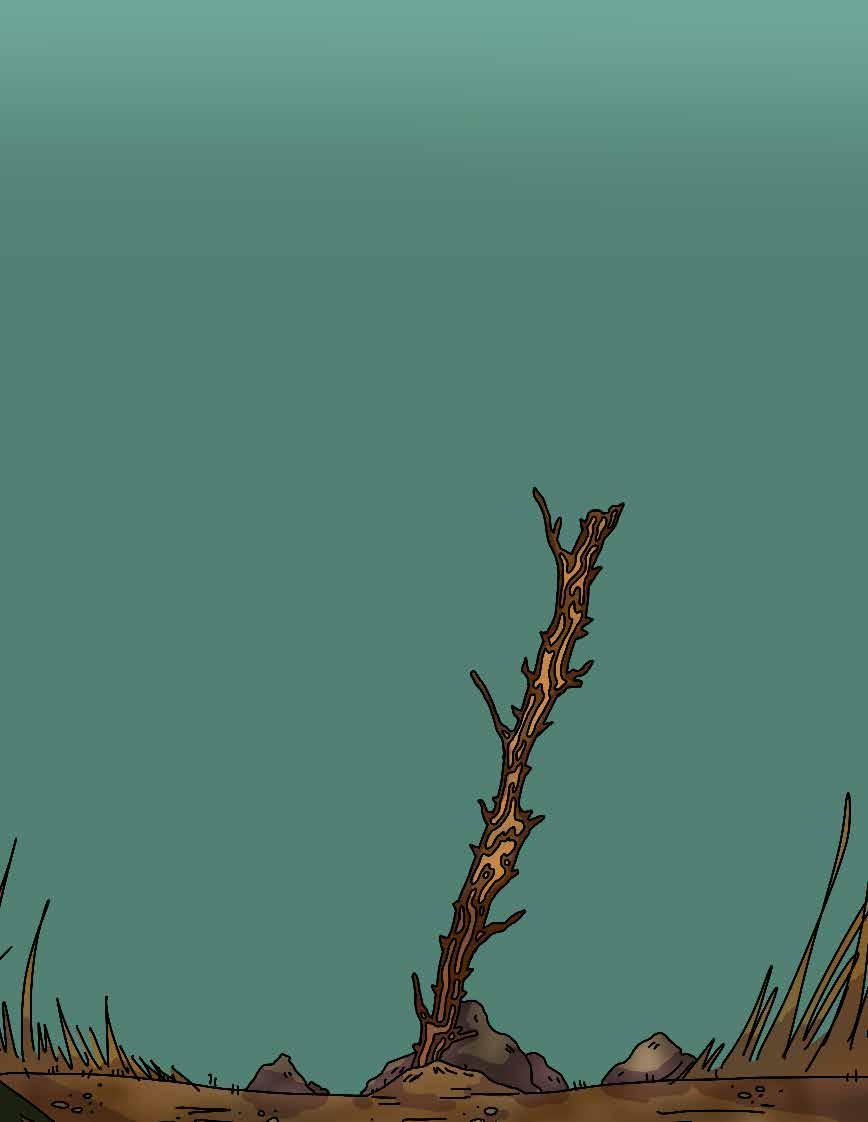
My mom claims it’s the “Bouwman blood” that is responsible for my brother and I’s clumsiness and lack of volume control. Bouwman is her maiden name, and knowing her side of the family, the “Bouwman blood” hypothesis isn’t the worst. My grandmother has bruised, broken, and beaten herself by falling, bumping into walls, you name it. The woman is

absurdly clumsy, but entirely indestructible. The amount of times I’ve witnessed uncles hitting their heads on things is astronomical. It’s probably the height, but as someone who has surpassed the coveted 6-foot mark, hitting your head all the time is mostly a byproduct of clumsiness. I’ve teased my mother about the fabled Bouwman blood on numerous occasions, but she sticks by it. Seeing as just a few days ago, I twisted my ankle going down the stairs, I think I believe it.
We had planned to take a family trip up to Foley Ridge, but my mom got called in for work. This happened for a while when she first started working retail, coworkers often failed to show up. We insisted that we could reschedule, but she had insisted even harder that we were going to go. And with that, we did.
Not much later, we stomped along our chosen trail, talking and laughing. My brother held up a large stick he found. It curved into itself at the top, creating an uncanny likeness to a wizard’s staff. A 5-foot-8, chubby, 13-yearold wizard to be exact. Gandalf in his younger years, perhaps. I walked with a stick I found,
Koda Mihm
Drew Campbell
47
Drew Campbell stumbles his way through a hiking trip with his brother and father.

48
too. It was carved from termites and was a rather large pain in the ass to hold because it had small pointy bits sticking out from every direction, but truthfully, that was no deterrent. You see, when a dude finds a cool stick, he keeps it; this is the dude creed. Knowing this sacred information, I kept it by my side at all times. Some traditions shall not be broken.
My father, reluctant about the stick religion, carried no stick. I teased him about it, and told him that he needed a stick (because he did).
As we walked along the trail, we stopped and noticed something peculiar. There was a hose, you know, the long, sort of flat kind that fills up and becomes round when water is pumped into it. It was huge and must have spanned hundreds of feet. We decided we needed to follow it. Well, follow it as long as we stuck to the trail, of course. Just saying, if someone laid out a trail of breadcrumbs to their creepy cottage in the woods, we’d follow it. Stupid? Yeah. Fun? Of course.
Soon, we took a hard right (the hose was going that way of course) and finally found some shade. We admired the forestry and examined the hose. My brother was less interested.
“Did you bring a snack?” he asked in his usual half-demanding tone of voice.
“What?” I thought to myself. We had been walking for no more than half an hour and this kid was already asking for food. I couldn’t imagine him actually surviving an intense trip. Stuck on some ridge, he’d fall to his death rummaging too hard through his backpack for some animal crackers. Gotta fuel the damn Bouwman blood, I suppose. I thought about my dad. There isn’t any “Campbell blood,” apparently. He must feel like a neglected dog every time the
topic comes up. I pulled a granola bar from my backpack and tossed it to my brother.
“Here,” I said. “Don’t eat it too fast, we’re not eating any more for a while.”
He thanked me and inhaled the bar with the aggression of 12 savage velociraptors. Another thing to add to the list of minor inconveniences, dad needed to take a leak.
We stood there patiently as he stepped off into a small covered area and adequately watered the plants nearby. Another thing in the “guy creed”: pissing in the outdoors is freeing, for some reason. As my dad returned, the caveman trigger went off in my head, and I realized I too needed to empty my bladder. Shortly after, so did my brother.
We reached a dead end on the path, a fallen tree, shrubbery enveloping the path. At that point, even more of my mother’s words echoed throughout.

“Make sure to spray for ticks, they’re really bad this time of year,” she warned. “Don’t go through tall grass or bushes!”
I mentioned this because, for me and my dad, that wasn’t something to worry about. We had no intention to go through tall grass, and besides, we had a plan: just use bug spray, wear pants, and hope for the best. My brother, on the other hand, well, for starters, he worries way too much about everything, and secondly, he has a vendetta against all things pants. He donned his usual blue pair of shorts, the hair on his comically hairy legs blowing gently in the wind.
“What if we get bit by ticks, guys?” he asked, clearly trying to play it off as a joke (it wasn’t a joke).
“We’re not going to get bit by ticks, buddy, we’re fine,” my dad said in his signature “don’t worry about it, what’s the worst that could happen?” tone.
After some thorough convincing, we
49

managed to get him to calm down and stop worrying about the bugs. In the thrill of the fat white guy pissing train and the greatest tick debate of all time, we once again spotted the hose, and it took a right onto a small, recently carved trail: narrow and bumpy. We decided to take the path and nearly fell over numerous times. My dad nearly falling over reminded me of a fishing expedition we embarked on the prior year. We just had to cross some railroad tracks, bushwhack through a small wooded area, and then head straight down a steep gravel incline. We didn’t catch anything, but it was a fun walk down, the kind where you make your own path.
Our clumsiness was on full display as the three of us sauntered along the strange little path. Eventually we reached a small hole. I jumped over it with the grace of a dying rhinoceros, the Bouwman blood at it again. We kept pushing on until we reached what we had been waiting for… an ancient temple ruled by a dark master, hellbent on conquering all who oppose him. I threw my stick like a javelin right at one of the cultists, blood gushing from his eye as he howled in pain, attempting to remove the stick from his eye socket. Well, that’s what I would say if we happened upon an ancient evil in the mountains, but no, instead we got hit with the incredible sight of a dead end.
Now, it was time for some action.
“Hey, this looks like the other side of where we were before we took the right turn back there,” I said.

My dad looked at the ground, thinking.
“If we keep walking this way we should reach the other side,” I said foolishly. My dad made the wrong choice and agreed to the plan. About 10 minutes later we were
standing out in the open in a place that didn’t resemble where we came from, at all. Shocker. I called myself an idiot, my dad laughed, and my brother went into panic. Just a typical Campbell family interaction.
I joked that mom would be worried sick if she found out what type of stupidity we had engaged in. Dad brushed this off, but my brother took it to heart and further convinced himself we were entirely stranded. Conveniently, there were three stumps just high enough to get a view of what lurked beyond. In what felt like a scene from a movie, we all stood on our respective stumps and gazed out into the distance. We saw nothing. Instead of being smart and turning around, we continued forward. After some more walking, complaining, and the monotonous whining of my brother, the brain cells finally collided and we agreed to return the way we came from.
After no time at all, we made our way back. In any other situation I would call what just happened a complete waste of time. But without that sidetracking it wouldn’t have been the same. It would have been far less interesting. We never did find exactly where the illusive hose led. For all I know, it did indeed lead to an ancient temple run by blood cultists that just so happened to need a bunch of water for their next ritual. That’s what I’ll settle on; it’s far more interesting that way.
Eventually returning to our vehicle, I stabbed my stick into the dirt, giving it a half-assed salute, and climbed into the passenger seat. We loaded my brother’s stick into the vehicle. No way in hell would we leave the wizard staff.
We drove in silence, the events still fresh in our minds. Nothing needed to be said, or at least until someone in the back seat suggested he needed another snack.
51
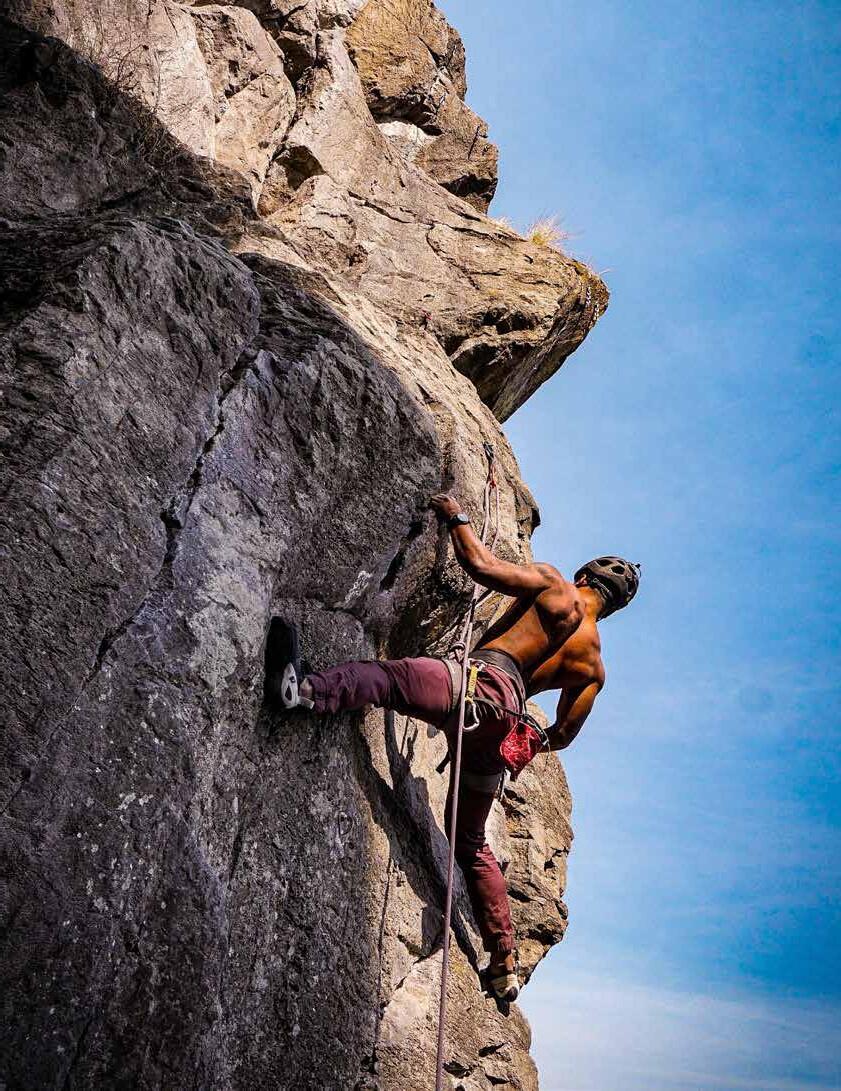 Andrew King clings to a rocky cliffside during an expedition in Pueblo, Mexico.
Andrew King clings to a rocky cliffside during an expedition in Pueblo, Mexico.
Bridging Worlds
Between Worlds Project founder Andrew Alexander King was raised in the projects of Detroit, Michigan. Though he’s accomplished much in life, even earning the title of “Most Influential Person in the Outdoor Industry,” bestowed by Outside magazine, he’s stayed humble throughout. Growing up in a household with his grandparents at the helm, his early childhood didn’t initially spark a love for nature. He says, “going outside meant just running up and down the block… in the projects, and just being in that part of life.”
Though his ability to explore the outside world arrived later, he displayed an aptitude for athleticism early on, stating, “we didn’t really have a lot of money. I did track and field for 13 years because our family wasn’t the most [wealthy]. It was the cheapest sport to do, and it’s fairly easy.”
The starting line wasn’t the only thing he was running from. “I ran a lot from a lot of things: from violence and bullies,” says King. “So… I didn’t really get into that level of outdoors until I was like… in my teenage years—my late teenage years. That’s when… surfing and climbing [were] something that became more adaptable and accessible.”
His yearning for something greater arrived through a peculiar avenue: his grandparents’ jobs. They were in the military, which suddenly brought nature to his front door, taking him from the projects of Detroit to the grandiose beauty of Hawaii at the age of 11. He explains, “we ended up in Hawaii, where I taught myself how to surf, swim, hike, and
climb… I got to really experience true nature and all of its beauty and lack of judgment.”
For King, metaphorical mountains were the first he had to scale.
“Asbury Park. That was a mental mountain because you had people dying in drive-by shootings,” he says. “Like, some of my friends growing up did die, unfortunately. Like, you never really know. And I say… we’re at peace with it. But I think when you look at [it on] that level, that’s a mental mountain as a kid, an individual growing up in that society, that you really have to learn how to climb every day.”
With the courage he obtained as a result of the mental hurdles he had to overcome, he summited his first physical mountain, Mauna Kea. Once he reached the top, he thought to himself, “wow, this is beautiful. Why don’t I do this more often?” He didn’t primarily recognize this feat as an accomplishment but rather a gateway to meditation.
The Between Worlds Project focuses on providing opportunities to those less fortunate by supporting many nonprofits and individuals that may require assistance in combating bigotry or economic barriers to exploring the outdoors. That’s where the name comes from, as it’s literally forming a bridge between different communities, or “worlds.”
 African American climber, surfer, and freediver Andrew King overcomes adversity to build his nonprofit, the Between Worlds Project.
Andrew King
African American climber, surfer, and freediver Andrew King overcomes adversity to build his nonprofit, the Between Worlds Project.
Andrew King
53
Kevin Gustafson
Early funding for the project was a bit hectic, though, as King was the only one who financially supported it, and many businesses doubted the project.“I’m giving up my bonuses and life savings to make sure it’s possible,” says King. “So I know… when you’re a multimillion-dollar corporation… don’t tell me it’s not possible.”
King always makes an effort to improve the communities he interacts with along the way, whether he’s on an expedition, a surfing trip, or just exploring the world around him. He recalls one such instance in detail, saying, “there’s a climbing gym here in Portugal, and it’s very small. It opened a few months ago… So I walk in… It’s not like the climbing gyms in America… where you have huge workout facilities and such… I meet the owner, you know, and I’m really excited for the gym. And then I’m like, ‘well, they don’t have any workout gear at all.’ And so I just went… and bought them some workout gear because I was like, ‘you leave a place better than when you found it. You support them on that.’ You know… and if you can’t, you just walk away. It’s more of like, how can I help [them]… And when you walk away, you open the door to understanding what struggle is from their point of view and their perspective.’”
To King, taking time out of his day to help others with the limited, precious time he has on this planet is far more fulfilling than any potential prestige. He would rather his friends have a great time, enjoying every moment, than be able to brag about whatever he accomplishes each day.
Even on the project’s website, King cares not to boast about how much he’s accomplished, as he only lists organizations that wish to be listed on the site. He would rather them ask to be put on the website than just use them as a credibility boost. Some of the partners King currently works with are Black Diamond, Backcountry, Sea to Summit, and Scarpa.

The Between Worlds Project is a way to build a global family, as King explains, “I don’t like to go to a place and just exploit their resources and use them… Nonprofits and the individuals in the community become family to me. And so every place I come back to, it’s a relationship. The mountains and the oceans are just pillars, or, I would say, blocks of wood, that we’re basically using to build that bridge to connect each other.”
Unfortunately, King has experienced many instances of bigotry, even in the workplace. “In work, you know, being the only African American, mostly, in a room where people are like, ‘Oh, you’re an African American,’ and you try to speak on something, but people think you’re not educated enough,” he says. “And I come from hav-

55

ing multiple degrees and certifications and such, [to] where you have microaggressions, where you’re not able to express yourself.”
Though King has experienced racial tension on multiple occasions, and sometimes straight-up racism, he tries to repurpose these experiences as a sort of “jet fuel” to propel his project and spread more positivity, since you can’t combat ignorance with ignorance; you’ll just end up with more ignorance.
Spiritually, the outdoors impact King greatly, offering him a place to be himself. He says, “whatever’s at the top of the mountain is already inside you. What I mean by that is, if you’re someone that likes to take photos by yourself, you’re gonna take a selfie by yourself at the top with no friends… If you’re someone that likes to be with a team, you’re going to get up there with your team and hug everybody… There’s no Zelda chest at the top of the mountain waiting for you… Those things are just platforms and stages for us to show what’s inside of us, and it brings out the best in you and the worst in you, depending on how you deal with it. It really forces you to confront your inner self.”
The outdoors are also a gateway to so many different peoples and cultures, as he explains, “I’ve met so many beautiful people… I find a place of peace and gratitude every day… I’ve met friends in the ocean. I’ve met friends in the mountains. I’ve met friends in hostels. I’ve met friends in people that taught me more about life and humbled me to really push myself to be more open-minded. So it’s impacted me not just in climbing and surfing and doing what these big feats are, but it’s really given me a real understanding of what the human species is capable of when we come together in a collaborative versus being combative and competitive against one another.”
Because of the interconnecting power of nature, he feels it’s important to diversify the outdoors, stating, “I think it’s important because nothing can be achieved by one individual demographic.” He continues, “It is a unified humanitarian issue to secure our sustainable outdoor activities… I truly do believe it’s going to take all of us, in a humanitarian sense… to really combat the issues that are going to be affecting not only us in this present time but our future generations as well… I think you have more stories and illustrations of what the outdoors means when you let other people be in that space to talk about it on [a] platform.”

57
Redefining Representation
Carolyn Finney grew up on a beautiful estate just 30 minutes outside of New York City with her adoptive parents. The estate resided in an extremely wealthy, all-white neighborhood, her family being the only black people living in the area. Because her parents were the caretakers for the estate, the Finney’s were placed in the upper echelon that many believed they didn’t fit into. She never felt as though she didn’t belong until one day, coming home from school at 9 years old, Finney was stopped by a policeman. He asked her what she was doing in that neighborhood. After she explained she was heading home, he asked her if the estate is where she worked. This was when she realized that her family’s reality appeared unusual to others.
Growing up on the estate allowed Finney to explore the outdoors at a young age. On any given morning she could look out upon the birch, poplar, northern red oak, and beech trees. She could sit at the pond and see the fish jump, the turtles bob, and the waterfowl flying overhead. This land is where she began to build a connection with nature.
“It was in my blood as much as it was in the soil because this is where I lived,” says Finney.
Despite her exposure to the outdoors, she was excluded from traditional outdoor opportunities. She recalls her father prohibiting her from going on Girl Scouts camping trips.

Finney says, “I understood that because I was a black girl, it was the 60s, and he [knew] what [could] happen… in the woods.”


Entering adulthood, her childlike fascination returned as she grew interested in place and belonging while backpacking around the world.
In 1997, a 20-something Finney and her then-husband bought $2,500 in plane tickets
Carly Bramhall
58 Marlon Co.
Author and world traveler Carolyn Finney emphasizes cultural and environmental inequalities across the globe.

from Pan-Am. The two of them hoped traveling would rekindle their passion for each other.
“We were struggling as a couple and thought let’s do this wild and crazy thing,” she says. “This will bring us closer together. That didn’t work. But what it did for me, it opened up a whole ball of wax. It’s like meeting a new love or something.”
She grew obsessed with adventure and travel books, infatuated with why people do what they do, how they do it, and the courage needed to do it, but “of course, I never found a single book by a person of color who did these things,” says Finney.
She returned to New York, saved money, and kept traveling. Residing in Nepal for a year and a half, she started thinking about nature as an extension of herself.

“I’ve only seen it in pictures… and suddenly I was in it,” she says. “So it was always connected to my idea of freedom, independence, mobility, access. I just knew I was really affected by it and I had to keep having more of it.”
Yet, Finney’s life in the United States, and as a result, her life in the outdoors, felt limited because of the color of her skin. In the 80’s, she pursued a career in acting, and was constantly told that she could only wear her hair a certain way and could only book certain roles because of the way she looked. At one point, she lost a job because she stopped straightening her hair.
Finney says, “I was having a lived experience in the United States… where it seems like what I could do as a young black woman was narrowly defined.”
She realized that going beyond the borders of the United States allowed her to go beyond the borders on her own lived experience. Finney eventually earned an undergraduate degree, and a professor urged her to get a master’s degree to broaden her range of job opportunities. During her studies she analyzed relations
in Nepal, specifically with community forest management and the place for women in that process. Diving further into academics, she decided to focus on geography, for it explored the concepts of people and place.
Finney says, “geography is for me inherently interdisciplinary and I loved that it wasn’t necessarily privileging people in the conversation about humans and the environment.”
Then Finney focused on race and environmental issues at home. Her family’s situation cemented this idea. When the original owners of her childhood estate passed away, their family tried to make it so the Finneys could stay on the property. Unfortunately, the Finneys could not afford to stay, but the original owners’ family built them a beautiful home in Leesburg, Virginia. Soon after the Finneys got settled into their new home, they received a copy of a letter from one of their neighbors in New York. It was given to all the homes in their old neighborhood from the Westchester Conservation Land Trust. The letter placed a conservation easement on the property to preserve the land and prevent the area from change. It explained its importance in the community from the wildlife on the land and where it sat in the watershed, to the abundance of tree species. The letter concluded with a word of thanks to the new owner for his conservation efforts. An acknowledgement of the Finneys’ care and consciousness of the land for almost 50 years was absent from the message.
Finney writes, “and just like that, my family was erased from the history of that land.”
In her book BlackFaces,WhiteSpaces, she poses some questions: “Whose land is this, anyways? And is ownership only about a piece of paper, or can it mean something more?”
She studied the history of conservation in America, exploring the absence of black people in literature and on backpacking trails. She started questioning the place of people of color and indigenous people in that conversation.
60

61
 Nicholas Nichols
Nicholas Nichols
Receiving over $100,000 to continue her work, Finney started studying African Americans’ environmental work. She moved to Florida for a year because she wanted to be closer to the Everglades National Park, Big Cypress National Preserve, and Biscayne National Park, beautiful ecological areas of environmental concern. While there, she continued to fly all over the country to interview people about their stories and the land that influenced them.
Much of Finney’s research stemmed from her interest in what she calls “the legacy of Contradictions.” The Homestead Act of 1862 allowed any European immigrant to own 160 acres of federal land with the intent to drive up settlement in the West. During a rush of ownership, black people were being enslaved, and Native Americans were being pushed out of land that they’d inhabited for centuries. Finney also acknowledges that when conservationists were advocating for national parks and the protection of people and place, Jim Crow laws prevented African Americans from participating in nature.
Finney Writes, “Yes—go on a hike! But also think about how power, privilege and our collective past informs our individual experiences. Consider who might have access and who does not (and why).”

Change does not come without acknowledging the need for reform. Finney encourages people to read stories about experiences that differ from their own. A willingness to listen and a willingness to transform is key.
Finney adds, “I’m saying something more about intentionality, and thoughtfulness, and honesty, about engaging the choices that we make as it relates to that nature outside of ourselves.”
If the narrative is “people of color are different; they are not us,” it becomes too easy to treat them unkindly, unfairly, and inhumanely. It becomes too easy to limit access to opportunities. People do the same thing with nature. Finney proposes that we think of ourselves as a part of nature and as a part of each other, and that only through this mindset may we find connection and compassion.
63

Olympic Ascendance
Kyra Condie overcomes a spinal fusion surgery to compete in the 2020 Summer Olympics in Tokyo.
In the past, Kyra Condie consistently found herself struggling to fit in, desperately wanting to impress others. Over time she molded herself into one of the best climbers in the world and no longer worries about such things. She spends the majority of her time perfecting her craft, in hopes of being the first female climber in the United States to win gold at the 2024 Paris Olympics. Condie fiercely scales 45-degree rock walls with ease, however, there is a noticeable difference in her climbing style when compared to other climbers of her caliber. Her style feels like firing up the wall with “reckless abandon.” Condie’s climbing style isn’t really a choice, rather it was more of a blessing that sprouted from perceived tragedy.
Born and raised in Shoreview, Minnesota, Condie’s parents often had trouble trying to keep her from scaling the confines of her crib. As she grew older, her ability to climb evolved, which only made it increasingly difficult for her parents to ensure her safety. As a toddler, she climbed larger furniture without fail. Her parents still recall finding her on top of the refrigerator one day. When she progressed into adolescence, neighborhood trees were targeted, but eventually, at a friend’s birthday party, she discovered the rock wall.
Condie, 11 years old at the time, quickly fell in love with sport climbing. Upon joining the local youth climbing team, Condie discovered a natural propensity for rock climbing. Her home gym, acted like a mirror of sorts. Although she enjoyed climbing, Condie came face-to-face with the anxiety of trying to fit in, which proved difficult because she was one of the only girls in the gym. Condie often found herself on the receiving end of sexist comments and jokes, as well as relentless teasing for being “weak.” Looking back, Condie still feels conflicted about how she was treated.
“I was one of the only girls climbing in the gym and I was one of the youngest,” she says. “Being both young and a girl, I think it was a lot of trying to prove myself.”
The year after she competed in the Youth Bouldering Nationals, Condie began to burn out. She found it difficult to twist her trunk and move sideways on the wall, her back aching as a result, but she simply brushed off the pain. Graduating to middle school, Condie began to lose interest in climbing, and her back pain grew worse. Condie asked one of her friends at the gym—a physical therapist—about her back pain, and discovered it was much worse than she knew.
 Caden Trieu Contributed
Caden Trieu Contributed
65

66
After consulting a doctor, Condie was diagnosed with severe idiopathic scoliosis—so severe that her spine had a 52-degree curve similar to the shape of an S. A group of doctors concluded that after a necessary surgery, climbing would be completely off the table. Devastated and unsatisfied with the news, Condie and her parents moved on to another group of doctors to get a second opinion. They, on the other hand, thought Condie would be able to climb again. However, after intensive spinal fusion, her trunk mobility would be severely limited.
Looking back, Condie had an optimistic view of how things would play out. Despite being forced to take a break from climbing for a few months, she found it beneficial to her growth as a climber.
“I took the time off climbing as a much-needed break that totally refreshed my look on climbing,” says Condie. “I had been getting kind of burnt out and the time off forced me to miss it and made me really realize how much I loved it.”
Condie’s vertebrae were fused together, meaning reaching certain spots on the wall proved challenging. Shortly after returning to the rock wall, Condie was met with another difficult challenge; her youth climbing team had been disbanded. As a result, Condie had to fine-tune her climbing skills without a coach or a team to support her through the remainder of her youth. Her motivation to keep climbing was mainly internal.
“I never thought of it as beating the odds,” says Condie.“I just knew that I was never going to let something like this get in my way. If I had dreams and goals I was going to keep trying to achieve them no matter what.”

After her spinal fusion, Condie began excelling in the world of climbing. She competed under the International Federation of Sports Climbing (IFSC), climbing in numerous competitions throughout the world. In 2012, she competed in youth lead and speed climbing. Throughout high school and her debut college years, Condie competed under the IFSC, but when she qualified for the Vail World Cup for the first time, it made her realize that she had the ability to compete at a different level, giving her “a taste of what it looked like to compete on the international level.”
Growing up, Condie always watched the Olympics, dreaming that she would one day be one of the
inspiring athletes on the big screen. The opportunity for Condie to become an Olympian was never guaranteed, but she continued to train and refine her skills to become one of the best female climbers in the world. In 2015, her fantasies of becoming an Olympic athlete suddenly seemed within her reach when the IFSC proposed to make climbing an Olympic sport.
In 2018, following her graduation from the University of Minnesota with a degree in animal science, Condie moved to Salt Lake City, Utah to be closer to advanced training facilities. She moved in with her good friend Allison Vest, a renowned Canadian climber she met in 2016 at a world cup event in France. This also conveniently placed her next to the Olympic Climbing facility where she would hopefully be training for the 2020 Summer Olympic Games in Tokyo.
Condie continued to compete, and as the Olympic Qualifying Event approached, she began to shine. In 2019, at the USA Combined Invitational Nationals, Condie placed first overall by winning the bouldering and sport round and placing 3rd in speed. She also secured the first spot on the USA National Team to compete in the 2019 Vail World Cup. Later that year, at the Olympic Qualifying Event in Toulouse, France, she finished in 7th place after making the finals. She came in 6th in speed, 8th in bouldering, and 11th in lead, securing an Olympic invite.
As 2020 began, following the nation and worldwide lockdown, the Olympic training facility located in Salt Lake City was shut down. Far from her home and family, Condie faced a new challenge: the Summer Olympics were delayed until the summer of 2021, and she had nowhere to train for them in the meantime.
Condie and Vest had to find new ways to train, simply starting with a hangboard above her door frame. Eventually, Condie and Vest turned their attic into a makeshift rock wall. The slant of their attic made the perfect wall for them to keep in shape. On weekends, long drives around Utah, or to Idaho, made for perfect outdoor getaways. They recorded their adventures and workouts, posting them on TikTok and Instagram to create a following and encourage others to start being active during the period of self-isolation.
As the summer of 2021 rolled around, the world seemingly starting to breathe again. Condie prepared for a trip to Tokyo, where she competed in combined climbing—a mixture of three disciplines: speed, boul-
67
dering, and lead climbing. In the first-ever Olympic climbing event, 20 women from 15 nations competed, and only eight of them would proceed to the finals.

In the end, Condie’s combined score placed her in 11th place. Her fellow American teammate, Brooke Raboutou, placed 5th, allowing her to advance to the final round. Despite falling short of a chance at an Olympic medal, Condie remained optimistic about her performance. In an Instagram post, she wrote: “I’d be lying if I said I wasn’t disappointed with my final result. I feel like with my spinal fusion, it’s a reality that I sometimes have to have luck on my side with route setting... Today wasn’t that day... I’m proud of my try hard and fight.”
Condie knows success involves much more than receiving a medal.
“I think I still find a lot of satisfaction when I think of the male surgeon who told me that I would have a family one day and wouldn’t need climbing anymore,” says Condie. “If I could see his face now and tell him what I’ve accomplished, I think that would be really satisfying. I definitely love being an advocate for climbers with limitations and showing people what they can accomplish, even with a large obstacle like a spinal fusion in your way.”
Condie doesn’t merely wish to reach the pinnacle of athletism, she also wants to be a champion for diversity. Condie’s goal is to make climbing a sport open to all walks of life, and as a board member of USA Climbing she hopes she can make the sport more accessible. She attributes her motivation for helping others to her experiences when she first started climbing. Back then, Condie would often receive degrading comments on how women shouldn’t have a muscular physique.
“I think I was pretty blissfully unaware of how much of a misfit I was in the gym community as a kid,” says Condie. “With so many adult guys climbing in the same space I totally just saw myself as one of them: a peer. But, obviously, that is not how they saw me. So I think the main way it affected me was making me feel excluded, but I was super determined as a kid, so I think it just pushed me more.”
For now, Condie’s focus is on the 2024 Summer Olympics in Paris, upping her training. But in a way she’s already won. In an Instagram post at the Tokyo Summer Olympics, Condie wrote, “I am, and forever will be, an Olympian.”

68
 Kyra Condie exercises her unique climbing skills as she free climbs a large boulder.
Kyra Condie exercises her unique climbing skills as she free climbs a large boulder.
Riding the Waves of Flow
South African native Mikey February utilizes flow and his knowledge of surfing to aid local communities.
 Hannah Holman Alan van Gysen
Hannah Holman Alan van Gysen
70

71

72
Mikey February strolls to the ocean in South Africa, preparing for a surf session.
Mikey February’s mind is occupied with daydreams of empty beaches and perfect waves—the kind of waves that appear glassy in the light of the sunrise as they roll onto the shore. For February, there is something surreal about the unknown of the ocean, and over time he has built a connection with the water where opportunities for creativity seem endless.
“You somehow find yourself in sync with what the ocean is doing,” says February, “and everything kind of just all comes together.”
The connection goes beyond just the ocean and involves the state of simply being in peace with nature. This abstraction perfectly expresses February, who consistently goes with the flow, often exhibiting this exact mindset in his surfing style, effortlessly gliding on waves that are often up to a mile long.
one end of the sidewalk to the other, making their way to the safety of the grass. It appears when a reader finds themself lost in a book, as if they are part of the plot and experiencing the emotions the author intended. In his book, Csikszentmihalyi explains, “flow is important both because it makes the present [instance] more enjoyable, and because it builds the self-confidence that allows us to develop skills and make significant contributions to humankind.”
Flow is more than just the act of being in “the zone.” Many researchers, scientists, and psychologists have explored the state of flow, which can be described as a moment where one is so immersed in an activity that all of their attention is completely focused on the task at hand. Not only does flow lead to excitement and genuine enjoyment in certain moments, but mastering the skill may be the key to a fulfilling life of happiness.
Mihaly Csikszentmihalyi underlines the steps and conditions for flow as well as how to control one’s consciousness in his book Flow: The Psychology of Optimal Experience. The conditions to enter this state are having built-in goals, being able to receive immediate feedback to analyze improvement, creating a set of rules, and overcoming consistent challenges, thereby furthering the development of skills. While it is possible for everyone, some are naturally better than others at entering the flow state.


“Just as some people are born with better muscle coordination, it is possible that there are individuals with a genetic advantage in controlling consciousness,” says Csikszentmihalyi.
Flow can come in the form of transfixion, the overseer intrigued, perhaps watching a snail inch from
February discovered flow in surfing when he was just a boy, mainly from watching his father, Isaac February.
“He was the first person that I saw who surfed,” explains February. “We’d go down to the beach and watch him and naturally would want to kind of do what he was doing.”
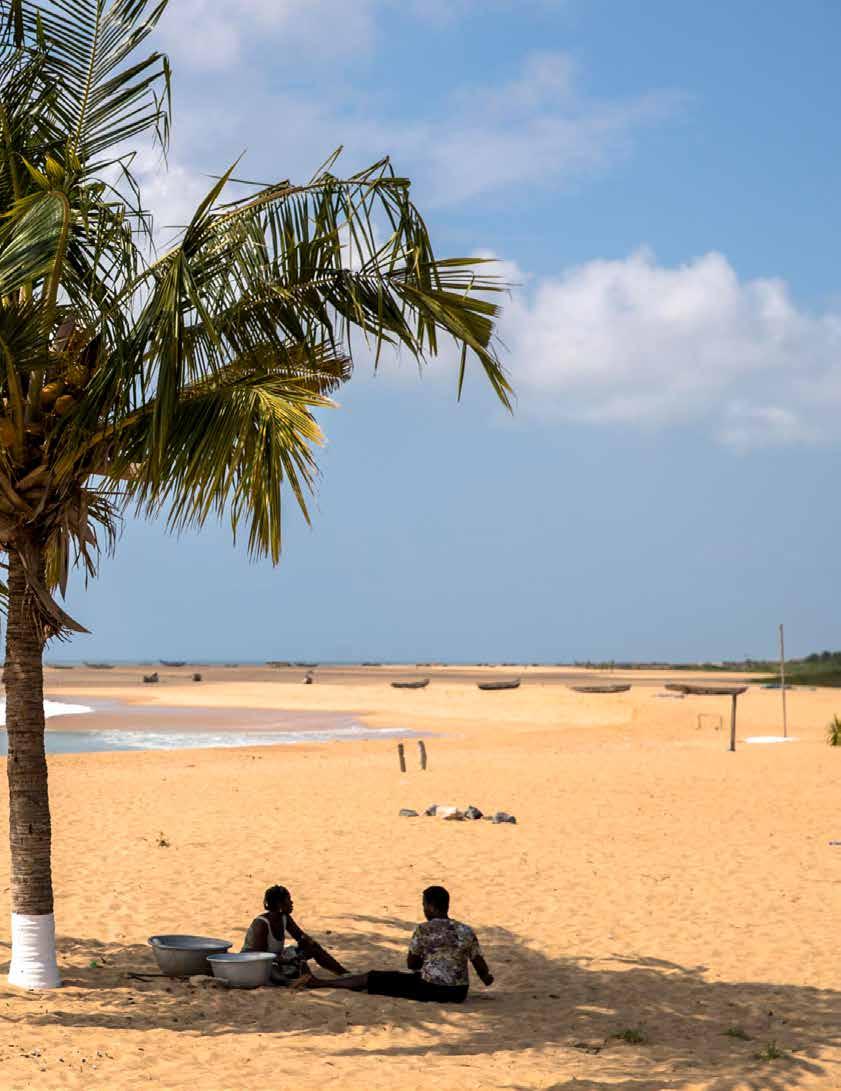
Growing up in South Africa, February’s father experienced the worst of the country’s troubling history. South Africa, a previous British colony, had a system of segregation called Apartheid. Although the country was no longer regarded as a British colony by 1961, Apartheid was not abolished until 1994, a year after February was born. Before 1994, even beaches were segregated, black surfers a rarity at best. Isaac chose to ignore societal norms, passing his skill to his son, who would eventually make surfing history.
February found himself connecting with small surf communities at several different beaches around his home in Cape Town. Constantly practicing, he developed his unique style before joining a bigger community in a town called Kommetjie, about an hour away from Cape Town.
“[I] used to spend pretty much every week [there] and then eventually, my parents saw that I loved it so much, and they ended up buying a house [in Kommetjie],” says February.
Soon February was doing things he had only previously imagined himself doing, gliding across swells and maneuvering through barrel waves, creating his
own form of self expression. February’s early successes helped launch his surfing career, grabbing the attention of the surfing world through a care-free approach.
In 2012, February began surfing in the World Qualifying Series (WQS) through the World Surf League. In the WQS, the best ten surfers move up and replace the bottom ten on the World Championship Tour (WCT). February spent five years fighting to secure a spot in the 2018 WCT, becoming the first black surfer from South Africa to qualify.
While this was an immense achievement, it was difficult to acclimate to the differences between the WQS and the WCT. Going from 100 competitors to only 34, things like specialized boards were necessary compared to the substandard equipment he had before. The tour also required a change in his surfing routine based on the types of waves they surfed. Throughout childhood and even in the WQS, February had always surfed notoriously “bad” waves.
“I feel like everyone should be able to surf good waves well, but going from eight years of just surfing bad waves, you kind of learn to make that work,” he explains.
The whole ordeal of becoming a surfer in the WCT took February six months to adapt to, but the realization that he was part of the most elite surf league in the world kept him immersed in the adventure.

“It was so exciting when I got on [the tour]... It was everything I imagined, but at the same time, it was also, I guess, intimidating and difficult, too,” he says.
Being a part of the tour is the ultimate goal of all pro surfers, but it comes with a lot of pressure. Ironically, half a year into the tour, February realized he no longer wanted to compete. He yearned for new ways to use his creativity to possibly give back to his community.
During the last months of February’s time on the tour, opportunities to work on several film projects arose. Through a partnership with Vans, he was involved in the 2018 documentary Can’t Steal Our Vibe, in which February and the co-founders of Positive Vibe Warrior Foundation advocate for under-resourced communities, sharing a love for surfing with South African youth. More recently, he has been part of two other Vans films—Sonic Souvenirs and Sonic
Souvenirs, Volume 2—that emphasize the importance and diversity of culture in Africa with music, art, and surfing. Suddenly, February had found ways to promote his values, using surfing as a way to spread awareness and help those in need, finding a different kind of flow in life.
In his book TheArtofImpossible, Steven Kotler poses a question: “What does it take to sustain high levels of peak performance long enough to accomplish a series of high, hard goals?” The ‘Impossible’ in the title is defined as something that one believes is beyond their capabilities, something a person could never imagine themselves doing. Compiling decades of research and experience on the science of flow, Kotler suggests the answer is striving to do the impossible. He states, “flow is to extreme innovation what oxygen is to breathing.”
Kotler describes flow as an infinite game that can’t necessarily be won but can maximize happiness and fulfillment in a person’s life. The game can be lost though, and Kotler insists that time is valuable.

“As social creatures, humans have an innate desire for connection and caring,” says Kotler. “At a basic biological level, we want to relate to others to survive and thrive, and, as a result, are neurochemically motivated to fulfill this need.”
At this point in February’s life, his purpose has come into view, one that compels him to use his experiences to help others. Coming from a surfing family who faced discrimination for the color of their skin, he believes everyone should have the chance to surf and feel a sense of belonging no matter what they look like or where they come from.
In 2017, he partnered with Positive Vibe Warrior Foundation as well as Waves for Change, a local Cape Town organization that promotes Surf Therapy and mental health for youth, and together helped to gather hundreds of surfboards and other surfing equipment to donate to children in South Africa. In 2020, February and his wife, Zelti, founded a non-profit organization called JUJU Surf Club.

74

75
JUJU’s goal is “uplifting and supporting surf communities in Africa,” which they have been able to do by collaborating with multiple other local organizations including Surfers Not Street Children, Waves for Change, Surf Pop, and many more. In an interview with Yahoo Sports, February suggested, “a lot of kids can’t really picture themselves doing this sort of thing. We want everyone who goes through our program to know it’s possible to gain mentorship and a love of surfing.”
For some flow comes naturally. February has moved seamlessly from one stage of his life to the next, tackling new challenges as they come. Now retired from the World Surf League, February has commenced a new chapter in life—starting a family.
Embracing fatherhood, February has connected his experiences in the ocean with the unknown waters of parenting. He wishes to pass on his knowledge, teaching his son that confidence is key and that he should always approach life with a positive outlook while keeping an open mind, always searching for a deeper sense of flow no matter what happens.
“Be confident in the fact that no one’s ever completely in control… be confident in that instead of having fear towards it because whatever is meant to happen is always going to happen,” he says.
February is now beginning to navigate through life together with his family, showing his son the ups and downs of life and mastering patience and harmony as a way to find success. During optimal flow experiences, a person loses their self-consciousness only to have it come back even stronger and more complex than before. This is how individuals grow to develop their sense of self: by finding activities where one feels like they are expressing who they are. Every surfer approaches waves in their own unique, distinctive way, just how every person approaches life differently.

“[Surfing] is this sort of blank canvas where you have to make split second decisions,” February says when describing self expression in the sport. “Everyone is so different… Every single wave is different… It is such a personal thing.”
Happiness may seem like such a high mountain to climb, but February has settled into a flow, the goal not to reach a summit but to keep riding the wave.

76

77

Fins, Fur, and the Future
Documentarian Ben Masters explores humanity’s legacy by telling the stories of North American wildlife.
Jay Bramhall Fin & Fur Productions

A mosaically scaled tail leads to a rotund lump of fur. The lump extrudes a pointed nose framed by two beady, glossy eyes and a hodgepodge of whiskers. The lump, once a rat known as the Bramble Cay Melomys, is now a chemically preserved warning of what’s to come. Australia announced the Bramble Cay Melomys official extinction in 2019. Humans’ involvement in extinction events is an infectious one. The end of the last ice age ended 11,000 years ago, and with it went several North American species lost to overhunting and human settlements. This pattern continues today, each decade marked by a death of the most conclusive kind — dodos in the late 1600s, stellar’s sea cows in 1768, labrador ducks in the 1870s, tasmanian wolves in 1936. The Melomys’ extinction represents the first chapter of the end, perhaps humanity’s last chance at salvation, to avoid spiraling further into climate catastrophe.
While Texas holds one of the highest concentrations of endangered species in the country, it also marks the birthplace of documentarian and conservationist Ben Masters. Born in Amarillo, Masters was planted in the deep soil of agricultural Texas, his days spent reddening under the southern sun, his passions cultivated under the calloused palm of a farming and ranching family. Learning about rotational grazing patterns and methods of securing the highest yield from a hay crop fostered an appreciation for the environment. Hours spent hunting, fishing, and observing land marked the beginning of a tranquility found little where else. A day of accumulating dirt under the
fingernails was often concluded with watching natural history and wildlife films.
“I guess I’ve always just been fascinated by land and especially by wildlife,” says Masters.
The allure only strengthened at university where he continued to study wildlife in a more classical sense. He says, “I went on to study wildlife management at Texas A & M University and that was really a gateway drug into the fascination of the natural world.” His worldly education continued over the summers, working at outfits in Northern Colorado, overseeing equine packing trips and trail rides. The working ranches of his youth primarily outfitted with four-wheelers, his summertime escapades were the first real exposure he’d had to horseback riding. “I just kind of fell in love with it,” says Masters.
Graduation presented Masters with two things: a degree in wildlife biology, and what he found to be an opportunity to change the world.
In 2010, Masters embarked on a trip across the West alongside a couple of friends. As classically broke college students, the group needed to save money wherever they could. To do so, they bought mustangs from the Bureau of Land Management’s holding pens. The mustangs were dirt cheap to purchase but nevertheless proved to be worth their weight in gold. The experience inspired the documentary Unbranded. Masters says, “the mustangs we adopted were pretty cheap, but they outperformed our domestic horses in every way.”

Experiencing the value of mustangs and thinking

79

80
Documentarian Ben Masters’ trail cams capture the elusive ocelot of the Rio Grande Valley.
about their place in the modernizing world stuck like a nasty cactus spine in his mind. Expansion throughout the West continues to push out wildlife, especially when coupled with the presence of an introduced species like mustangs. Most organizations’ solutions to overpopulation look like aluminum panels and cramped holding facilities.
Masters’ solution looked like another packing trip, very similar to the one he took in 2010. “We made a documentary called Unbranded that was about these four fellows that rode some mustangs that they adopted from the BLM, from Mexico to Canada to create a film about public lands and bad horse management,” he says.
His three partners—Ben Thames, Thomas Glover, and Jimmy Fitzimmons—rode through Arizona, Utah, Idaho, Wyoming, and Montana on horses taken off the range after four meager months of training. Unlike his previous trip, there would be no domesticated horses to fall back on, no comfort in knowing that the animal beneath his legs holds years of training and trust. “I mean, training a wild horse, it was something that you should really take very seriously before you get one, it’s a huge responsibility,” says Masters. “And it’s one that requires a skillset that not a lot of folks have.”
The mustangs went to trainers Jerry Jones and Lanny Leach for 30 days, before spending the remaining three months with the men. “I would say that… one of the most terrifying and rewarding, and exciting, and frustrating, and patience building endeavors that a person can take in this life is just adopting a wild horse and taking the time to acclimatize it to your presence, to your touch, to the saddle, to a bit… doing everything you need to do to train a horse,” says Masters.
Cowboy hats adorned and leather straps fastened, Masters and friends desensitized the horses to unfamiliar weights and pressures notably absent from life on the plains. The rising warmth of a new day symbolized an opportunity to learn for both rider and horse, wherein a setting sun signified the resounding fear of asking a mustang to return to the wilderness but not its wild mind. The level of trust required between rider and horse is extreme, even in controlled environments not subject to the whims of nature. When crossing thousands of miles of treacherous terrain, the rider has to acknowledge that the landscape they traverse belongs more to the mustang than man, while the horse must remain surefooted and strong, confident in their rider’s promise to lead and protect.
Ready or not, on April 1 the men were off, horses and questionable sanity in tow. The proceeding five months proved laborious. Early mornings and endless nights sustained by canned food and the thrill of adventure. Cantering through cactus country, spiraling serpentine canyons, and summiting rebellious rock faces contributed to a journey hard won. However, mother nature wasn’t the only test of the riders’ will.
Barbed-wired private property emphasized an essential point made in the film, when land continues to be doled up and divided, the wilderness becomes fragmented. Not only did it force the men to reroute, but it also has prevented many western species from accessing the sprawling land needed to fulfill their nomadic lifestyle. Critics shout from the rooftops over the unfairness of capturing mustangs, ignoring that they have nowhere else to go, and their rising populations makes the situation even more tumultuous. Masters explains, “it’s crazy to allow a non-native species just to take over precedence of native wildlife and to knowingly just allow the population to go way beyond what is an appropriate number on the landscape.”
Train tracks, fences, roads, and invisible territory lines splinter the balance of century old ecosystems. To live off a crumbling landscape is to suffer painful and slow starvation of the stomach and the soul. At one point, an encounter with offroading vehicles that mimicked the sounds of the helicopters used to round up the mustangs into BLM corrals scattered the herd over the countryside, resulting in backtracking and mass frustration.
“I think anytime you do such a large trip with that amount of people, there’s going to be disagreements,” says Masters. “And I think one of the really amazing things that I got to see through that film is myself through other people’s eyes. I mean, how unique is that? To be able to have a third person objectivity and actually get to see yourself and how you interact with other folks and the good and the bad,”
He adds, “I learned a lot about myself, but at the end of the day, we successfully did a 3,000 mile journey with four friends and had a handful of disagreements. None of them were so bad that we actually [started] beating each other up.”
Two horses sustained injuries on the ride, forcing them to exit the trip. Another horse, Cricket, sustained fatal injuries after running off and breaking his neck, the stillness of his death conflicted with his large, startlingly elegant body. Fitzimmons cut off a portion of his

81
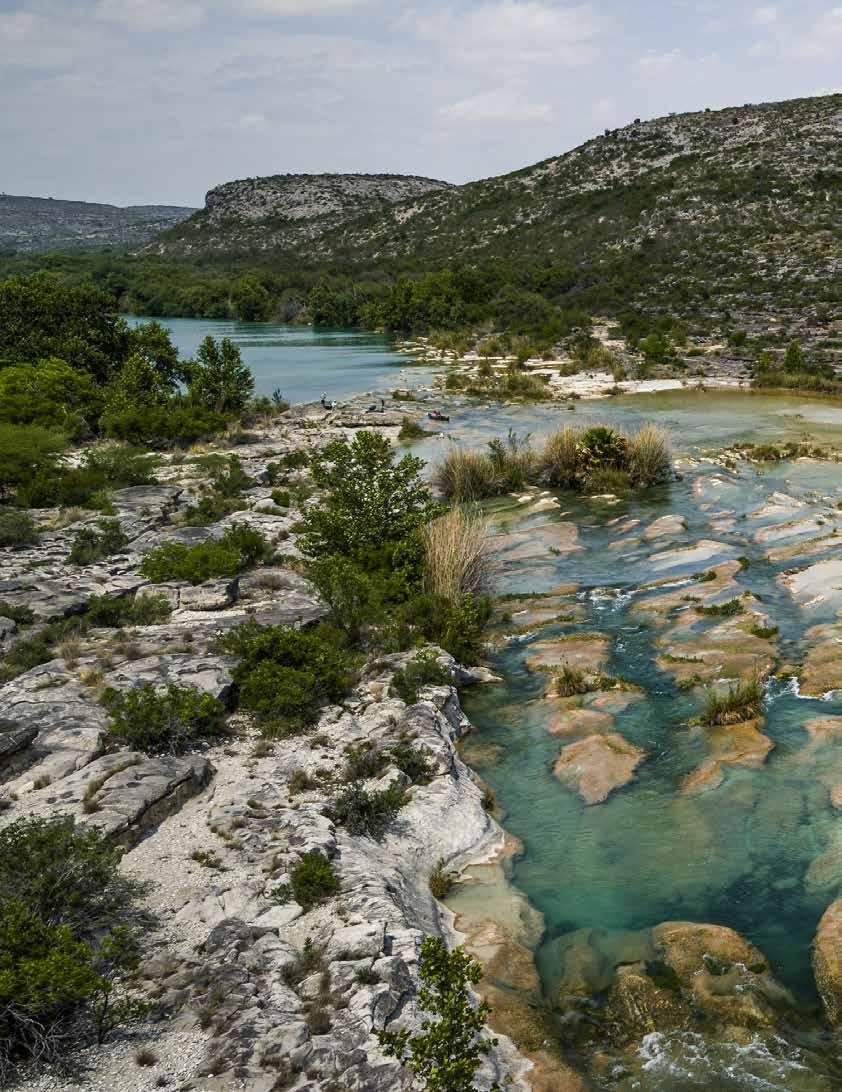
82
Ben Masters highlights the beauty of Devils River, a drainage basin for the Rio Grande.
tail ensuring one piece of Cricket made it to Canada.
But Fitzimmons never made it to Canada. A mile from the border, Fitzimmons sat on a log announcing to the group he’d asked his dad to pick him up at the Lee Ridge Trailhead. “I think sometimes there’s beauty in leaving some things undone,” Fitzimmons says.
Masters struggled with the decision, taking it as a personal loss. A failure to truly complete his goal of crossing every square inch of the ride as a cohesive unit. Looking back, it appears Fitzimmons only accentuated finer intricacies of the journey.
“The story started with just being about the horses and public lands and conservation,” says Masters. “What I certainly didn’t recognize at the time was how big of a film it was on personal growth.”
Unbranded wasn’t a story about conquering the land. It wasn’t about pioneering a new trail from Mexico to Canada, obstacles be damned. It was a story of connection. The connection between four men and the strength of those bonds. The connection between horse and rider, the connection between land and life, the horse that thunders over the grasslands and the man that cuts through it.
Ending the film, Masters says, “I hope to God that in a hundred years, there’s still a backcountry route to ride from Mexico to Canada. And that’ll require sacrifice...in a society willing to face difficult decisions...and a really good horse.”
try to tell respectful stories and try to film stuff nobody’s ever seen before.” In a mediascape clouded over with the doom and gloom of the climate crisis, despair walks hand-in-hand with complacency and inaction.
With two feature length films and six short films on the docket, Fin and Fur Films is Masters’ response to excuses of hopelessness.
After releasing Unbranded, Masters directed Selah: FromWatertoStone, a story of restoration in Texas. David Bamberger purchased some 5,000 acres of desolate wasteland, and in a twist on Biblical apologue, turned stone to water using native grasses that had nearly disappeared on the property due to previous overgrazing. Bamberger proved that change can happen, that the end isn’t always gilded in devastation.
Then, came a slew of other short films and a couple of features, all directed by Masters, many of which were possible due to the release of Unbranded. Pronghorns gliding over the prairie, rapids ripping through rivers, mountain lions ruling as masters of the Texan outback and the slippery silver of fish scales illustrate Masters’ character better than words ever could. He sees the beauty of a land respected, the innocence of the creatures who rely on it, and the complexities of private land ownership and agriculture.


“I’m fully cognizant of how fortunate we are to get to tell these amazing stories and feel a lot of responsibility to do a good job in telling them,” he says.
To release Unbranded, the film needed a production company name backing it. Ever the hunting and fishing enthusiast, Masters landed on “Fin and Fur Films” as a name for his Texan-based company, establishing a life for himself dependent on the outdoors.
Emmy-nominated, Fin and Fur Films releases three to five short films a year, interspersed with a feature film every couple of years. Their films have been distributed world-wide in theaters and on prominent platforms like Netflix, National Geographic, and Starz.
“I don’t consider myself to be an incredibly good filmmaker. …for whatever reason, I’ve been able to attract really top end just wonderful human beings to work with over the last couple of years... and we’re just rocking and rolling,” says Masters. Fin and Fur Films is a successful production company because it’s made up of people who care. “We try to tell nuanced stories. We
After Unbranded, Masters’ films have remained stationed in his home state of Texas. “It’s hard to make a film where the audience is the entire world, but if you break it down to Texas… and if you can have that more specific audience, I think it allows the people who live there, who actually know that landscape, to connect to that movie better.”
The River and the Wall, Masters’ second feature, educated its audience on becoming well-rounded adventurers. Masters’ team traveled on bike, canoe, and of course, horseback through the wild borderlands of Texas from El Paso to the Gulf of Mexico.
Following 2016, the conversation about building a border wall between Mexico and the United States encouraged Masters to put together the trip a year later. Alongside river guide Austin Alvarado, National Geographic filmmaker Filipe DeAndrade, conservationist

Jay Kleberg, and ornithologist Heather Mackey, Masters scrutinized what exactly a mass of concrete and wire would do for the country and its inhabitants, both twolegged and otherwise.

The proposed wall would be built alongside the Rio Grande, an ecological hotspot strained under pressures of immigration control and private property conflicts. Texas is the second largest state, and 95 percent of it is considered private property. Much of that land resides next to, and across, the Rio Grande, some of the last true wilderness in the state. National parks, generational farms, and wildlife protection areas line both sides. A border wall would compromise the land, for landowners and wildlife alike, without addressing the root problems of border control and drug trafficking.
Stunning cinematography ripples off the valley carved by three million years of the Rio Grande’s triumphant cavalcade, forcing the audience to acknowledge the landscape as more than a convenient perimeter. The film isn’t an answer, it’s a reconciliation—a caution that nature doesn’t create rivers as mankind’s blueprints. Children from Mexico and the United States alike splash in its waters, unaware or uncaring of an invisible barrier. Animals, like the reintroduced black bear and bighorn sheep, drink from the river, the only dependable water source in the area. More than a delineation, the Rio Grande is a pretext for community. The dedication at the end of the film says: “Dedicated to the Rio Grande, a river before it’s a border.”
The Rio Grande border wall is an ongoing battle, one fueled by intentional ignorance, and it’s only due to people like Masters that the entire countryside hasn’t been stuck behind a chain link fence like a junkyard dog.
for wildlife, while the Crosstimbers act as a barrier of woodlands between open plains. The South Texas Plains make up the majority of the southern region and are bordered by the Edwards Plateau. The High Plains and Rolling Plains make up the northernmost area of Texas, whereas the Trans-Pecos contains some of the most complex terrain of any ten of the regions. Far more than tumbleweed iconography, all 266,807 square miles of Texas hold different ecological implications. “This is a story for all who love Texas,” rumbles Matthew McConaughey in Deep in the Heart: A Texas Wildlife Story’s introduction.
The film catalogs the history of obsolescence in Texas.
“The conservation challenges in Texas are so large that it’s a good use of my time and skillset to stay here and try,” says Masters. “I try to capture a lot of these visuals and a lot of stuff that I film may become locally extinct or full on extinct in my lifetime.” The infringement of life on wild sheep, pronghorns, deer and elk—removing the animals from all but the most vitallic land and a reprobation of the eradication of jaguars, wolves, and grizzlies in Texas. Stony images reveal thousands of animal skulls piled to the heavens, the first skyscrapers of the West. Bison bodies litter the ground, bodies reduced to pest control when their hide and tongues are removed. Full of poison, their flesh kills off any remaining predators on the suffocated land. Once a wave five million strong, the bison herd dwindled to five.
Due to strong conservation efforts, bison numbers are now in the hundreds. Similar stories of devastation and restoration riddle the West.
Home is where the heart is, and Masters’ heart resides in the Texan outback. In June of 2022, Fin and Fur Films released DeepintheHeart:ATexasWildlifeStory, doubling down on local conservation efforts. “So I just feel like my services are kind of needed in Texas right now,” says Masters. “Plus it’s my home, I grew up here and I feel like I can do a good job telling these stories… [and] I just feel like it’s the right thing to do.”
Divided into ten ecoregions, the Lone Star State is startlingly diverse. East Texas houses the Piney Woods and the Gulf Coast prairies and marshes. The Post Oak savannah and Blackland prairie mark transitional areas
In the areas not governed by outside agencies, private landowners have begun supporting research and conservation efforts on their properties. On one such area, along the Rio Grande Valley and Plains, resides the ocelot, a wildcat who’s U.S. population is estimated to be less than 100. Overhunting and severe habitat loss have shrunk the cats to two isolated populations, creating inbreeding and further population decline. “We’ve spent years documenting Ocelots and there’s a hundred of ‘em and they’re one bad hurricane away from being wiped out.”
Masters planted cameras throughout the Texan brush of the cat’s habitat in attempts to glean insight into its cryptic life, footage that premiered on an episode of PBS’ Nature titled American Ocelot. “The ocelot is somewhat of a Holy Grail for wildlife filmmakers,” says Masters in the film. “They’re rare, and in my opinion, they are the most beautiful cat species—possibly the most beautiful


85

86
animal there is.”

Three years of filming the elusive cat using trail cameras and trap cinematography, Masters revealed a world shrouded in rosettes while also amplifying his own. Caught between tears and laughter, a state akin to rapture, in American Ocelot Masters says, “we got it. Those are—We got the ocelot kittens.”
He turns the camera, revealing footage of a mother cat, affectionately named Mama Jane, and her two kittens. Masters and his team are the first people to ever observe a wild American ocelot mother and kittens. While filming the kittens, Masters received the second great joy of his lifetime, the birth of his daughter, Birdie.
Mama Jane offered more to Masters than scientific discovery, she unwittingly mentored him in the raising of his own child in a dangerously developing world, showing him the risks that must be taken by parents to ensure survival, and the delights found watching youth explore the natural world. “You think a lot about the future when you have a kid, what lessons you can teach them that will set them up for success, what skills you can pass on,” says Masters in the documentary. “You’ll do pretty much anything to give them the best chance at life.”
Adorned in butterfly cowboy boots, Birdie followed her dad into the bush. Where he crawled, she strutted, mimicking a comfortability with wildlife that’s defined Masters for decades. American Ocelot is a story about endangered wildcats, but more than that it’s a story of legacy. Of not just the people we create, but the land we leave behind.
Mama Jane’s sole surviving kitten was dubbed “Hope.”
“Hope that landowners, state and federal agencies will work together to recover this incredible species and begin new populations in the United States. Hope for our children to inherit wild landscapes teeming with our most magnificent cat,” Masters says in American Ocelot
Birdie and Hope represent the new age of conservation, the kids who received a fractured world without a certified manual on how to put it back together again. All they’ll have is the legacy of their ancestors to learn, both the good and the bad.
“I think my grandkids and my kids will possibly look at our generation as the generation that had a chance to right a bunch of wrongs and they probably didn’t,” says Masters. “I don’t think our generation’s going to rally around preventing a lot of our extinction crisis and overpopulation crisis and climate change crisis. I just don’t, I don’t see humanity doing that.
“But I hope people watch our films and they realize that, goddammit, there was some son of bitches that lived back then that gave it every fucking thing that they had. If we can, if our films can help that out, I can’t think of a better thing to leave behind.”
87


 Fin & Fur Productions
Fin & Fur Productions










 Rena Olson hugs a massive tree on the Yakona Nature Preserve.
Rena Olson hugs a massive tree on the Yakona Nature Preserve.










 Climber and USC runner Lucy Westlake marvels at a mountain view sunrise.
Climber and USC runner Lucy Westlake marvels at a mountain view sunrise.
























 Bridget Franek runs in the 2012 United States Olympic Trials at Hayward Field.
Bridget Franek runs in the 2012 United States Olympic Trials at Hayward Field.




 Cedar Wright poses for a photoshoot with The North Face.
Cedar Wright poses for a photoshoot with The North Face.










 Amanda Arch Koda Mihm
Amanda Arch Koda Mihm











 Andrew King clings to a rocky cliffside during an expedition in Pueblo, Mexico.
Andrew King clings to a rocky cliffside during an expedition in Pueblo, Mexico.
 African American climber, surfer, and freediver Andrew King overcomes adversity to build his nonprofit, the Between Worlds Project.
Andrew King
African American climber, surfer, and freediver Andrew King overcomes adversity to build his nonprofit, the Between Worlds Project.
Andrew King









 Nicholas Nichols
Nicholas Nichols


 Caden Trieu Contributed
Caden Trieu Contributed




 Kyra Condie exercises her unique climbing skills as she free climbs a large boulder.
Kyra Condie exercises her unique climbing skills as she free climbs a large boulder.
 Hannah Holman Alan van Gysen
Hannah Holman Alan van Gysen






















